Archive for the ‘Veridion Adventures’ Category
Day by day the rains lessen. Day by day the sun is breaking through a little more, warming up the ground and consequently the air. Evaporation causes the relative humidity to rise. We are almost there, almost into the dry season. It won’t be long before we start to lament the lack of precipitation but let us at least enjoy the first few dry weeks without complaint. There were five days with almost no rain but it was a false start to the dry season, the rain returned, not heavily, but rather grey days with drizzle.
Coloring Time
The increasing temperatures and decreasing precipitation seem to have stimulated flowering in at least some of the plants. There is one small bush that has produced a display of flowers. It has the captivating name of Yesterday, Today and Tomorrow, (Brunfelsia grandiflora). The name refers to the rapid color change in the flowers. When the bud bursts and the new flower blooms, it is a light lilac color. By the following day the hue will have started to fade and then several days later the now white flower falls from the bush.
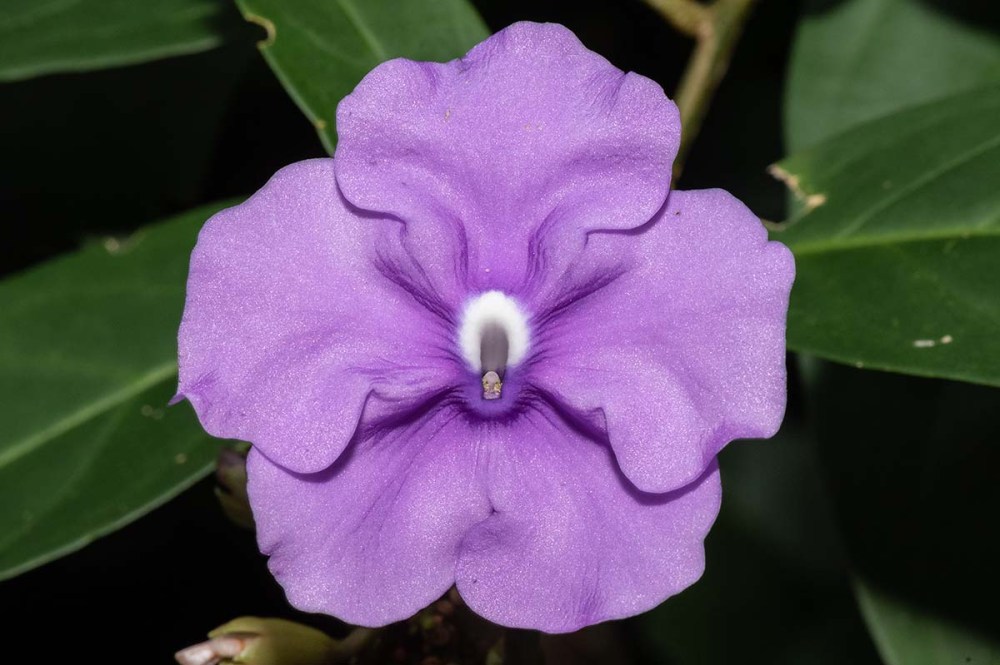
Yesterday, Today, Tomorrow, (Brunfelsia grandifolia). Flower
Yesterday, Today and Tomorrow is native to the northern part of South America. It belongs in the nightshade family; Solanaceae. It is planted in many Costa Rican gardens to provide a showy display of changing colors. The flowers are also fragrant and attract bees.
Color Sensitive
Many people are familiar with the Sensitive Plant, (Mimosa pudica). It has the entertaining habit of closing its leaves on contact or as night falls. It is a very low growing plant found sprawling along the edges of paths and roads. It is a native to Costa Rica but has now been naturalized in many tropical areas around the world.
The short-lived flowers are a deep lilac fused with red and are pollinated by bees. But the most intriguing thing about the Sensitive Plant is the ability of the leaves to fold up. At night the plant exhibits a behavior known as nyctinastic movement. As the sun sets are darkness envelopes the forest, the leaves of the Sensitive Plant fold and close together. As the sun rises, they open up again.
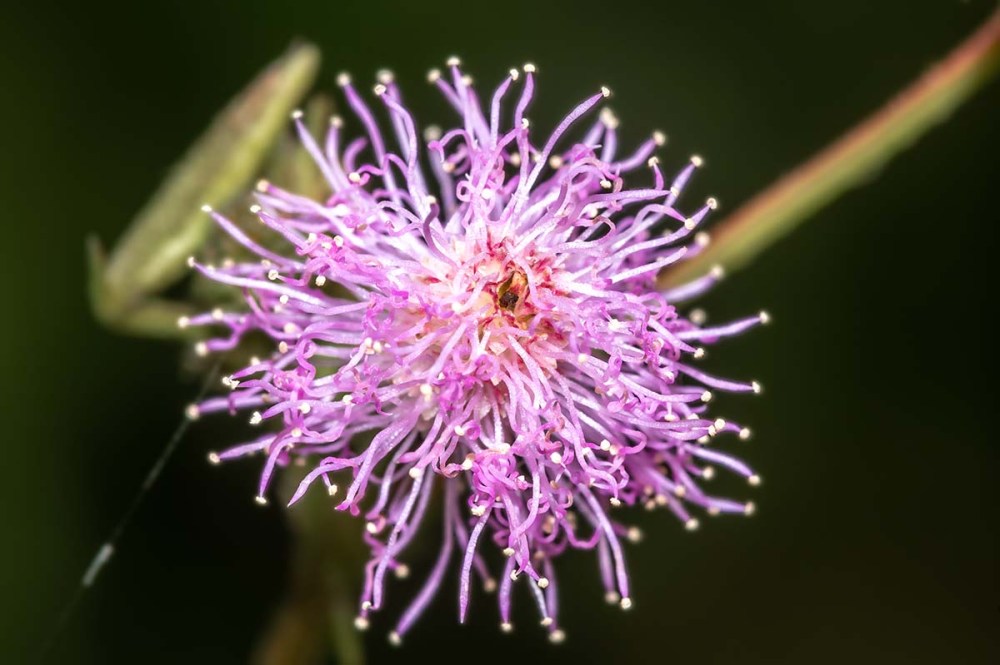
Sensitive Plant, (Mimosa pudica). Flower
But more familiarly, if touched the leaves immediately close, a phenomenon known as seisonastic movement. The means by which this happens is fascinating. Contact with the leaf causes an electronic impulse to be passed along the leaf which in turn stimulates the transfer of potassium out of the cells at the base of the leaf which then lose water and become flaccid and collapse. This is an energy expensive reaction from the plant to external contact and therefore must convey some benefit. As of now, we are not entirely sure what this benefit is. It could well be that it makes the leaf less appealing to herbivores or when it rains reduces potential damage by being smashed against the ground. Whatever the reason it certainly compels people to tap it and watch the response.
The Sensitive Plant is also an important nitrogen fixer. It releases a compound from its roots that inhibit certain pathogenic fungi growing near its roots. The roots have nodules which contain nitrogen fixing bacteria. The bacteria do something the plant cannot, they take atmospheric nitrogen and convert it into a form usable by the plant. Plants require nitrogen for many aspects of their lives, not the least of which being the growth of tissue. Up to 60% of the Sensitive Plant’s nitrogen requirement is provided by the root-dwelling bacteria which allow it to thrive in areas where the soils are nitrogen deficient.
Purple Rain: Lavender and Lilac Light Up The Forest
There are several other small herbaceous plants that can be seen on the forest floor or around the gardens that have lavender or purple coloration. Here and there an isolated small purple bell-shaped flower can be found. The small bloom stands out in contrast to the deep green of the surrounding vegetation. This is Monopyle sp of the family: Gesneriaceae. Growing in the same localities but with a larger, shrubbier aspect is the Portaweed, (Staphytarpheta frantzii), which is in the family: Verbenaceae. The butterflies, particularly skippers, seem to be attracted to the Portaweed flowers. Both of these plants are native to Costa Rica.

Monopyle sp. Flower.
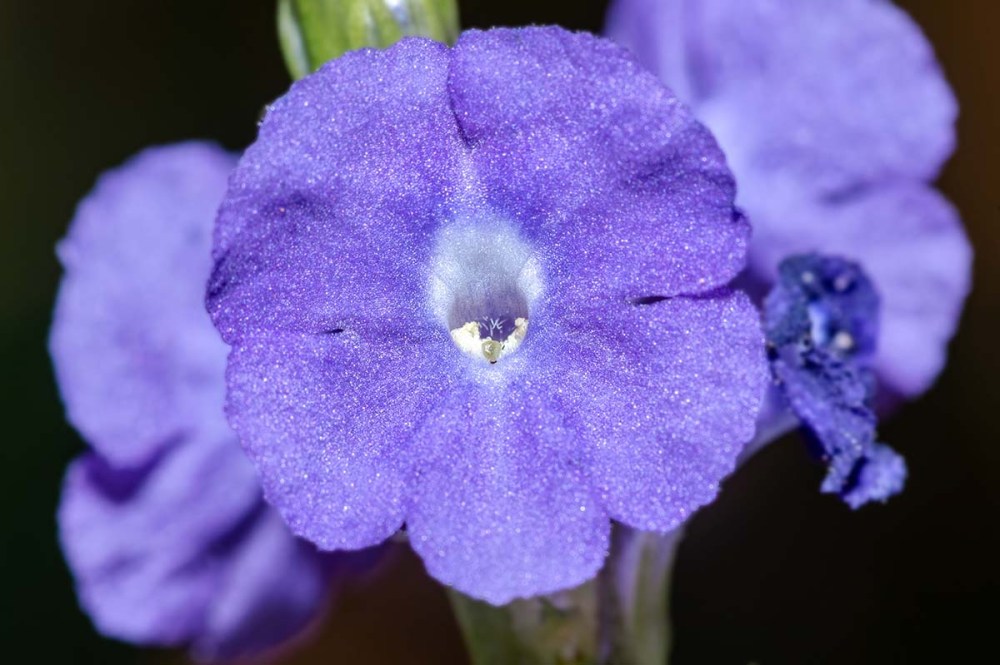
Portaweed, (Stachytapheta frantzii). Flower
Whereas both of the above plants are low growing and herbaceous, there is a tree that produces a spectacular display of flowers in the canopy, so much so that they are planted in Costa Rican town streets for their attractive blaze of color. These are the Jacarandas. When the flowers finish blooming they fall to the ground and cover the forest floor in a carpet of purple. A native Jacaranda in the forests of the Osa Peninsula is Jacaranda copaia, family: Bignoniaceae. When it does flower, the canopy is enriched with its pigmented presence. Afterwards, it provides a brief but colorful change to the normally dull red mud of the forest trails.

Jacaranda, (Jacaranda copeia). Flower.
Too Blue To Be True
Flowers tend to divide into 3 distinct classes with regard to color; red, orange and yellow or pink, lilac and lavender or white, cream and green. The different colors favor different types of pollinators. Red, orange and yellow attract birds, namely hummingbirds, pink, lilac and lavender are visited by insects, particularly bees, finally whites, creams and greens normally have nocturnal pollinators such as bats and hawkmoths.
The different colors are produced by different pigments. Plant pigments fall into four categories. Chlorophyll is a name most people will be familiar with, certainly to some level. It is responsible for the vitally important green coloration of plants. Carotenoids give rich reds, oranges and yellows. Flavonoids give the deep red/purples as well as blacks, browns and white. Betalains produce red/violet and orange/red. Things are not as simple as outlined above as there are many overlapping shades and hues.
The one color noticeable by its absence is blue. Blue is not a common color in plants or animals. Less than 10% of the named 280,000 species of flowering plants are blue in color. Plants that have blue flowers have done so with a little bit of manipulative trickery because there is no true blue pigment found in plants. Anthocyanins are a flavonoid pigment responsible for many red flowers and fruits. By mixing some of the pigments and altering the pH a blue color is produced. This produces some spectacular blooms such as Bluebells, Delphiniums and Morning Glory.
Day by day the rains lessen. Day by day the sun is breaking through a little more, warming up the ground and consequently the air. Evaporation causes the relative humidity to rise. We are almost there, almost into the dry season. It won’t be long before we start to lament the lack of precipitation but let us at least enjoy the first few dry weeks without complaint. There have now been 3 dry sunny days in succession. It doesn’t take long for the muddy trails to start drying out.
Biodiversity Most Ordinary: Net-winged Planthopper
There are certain insects that you see regularly in a variety of locations but they don’t excite your interest because there is nothing outstanding about them; no bright color, no unusual shape or weird behavior. They are just a general insect.
Net-winged Planthoppers fall into this category of ordinary. I see them but I am never inspired to point the lens in their direction. Last week as I was searching the vegetation, scrutinizing the grass blades and poking around on the ground looking for a subject that I may have never seen before, one of the Net-winged Planthoppers landed in front of me. Well here was an opportunity to photograph something even if the subject was mundane.
I am probably doing the Net-winged Planthopper a disservice as they are as important as everything else within the complex system of interactions that make up the tropical rainforest ecosystem. They are true bugs and belong in the homopteran family: Nogodinidae, which taxonomically is regarded as being Neotropical. Information regarding their life histories are non-existent at worst to scarce at best. I think this individual is one of the 3 known Biollyana species, possibly Biolleyana costalis. They are plant sap feeders and use the long piercing mouthparts to tap into the plant’s vascular system.
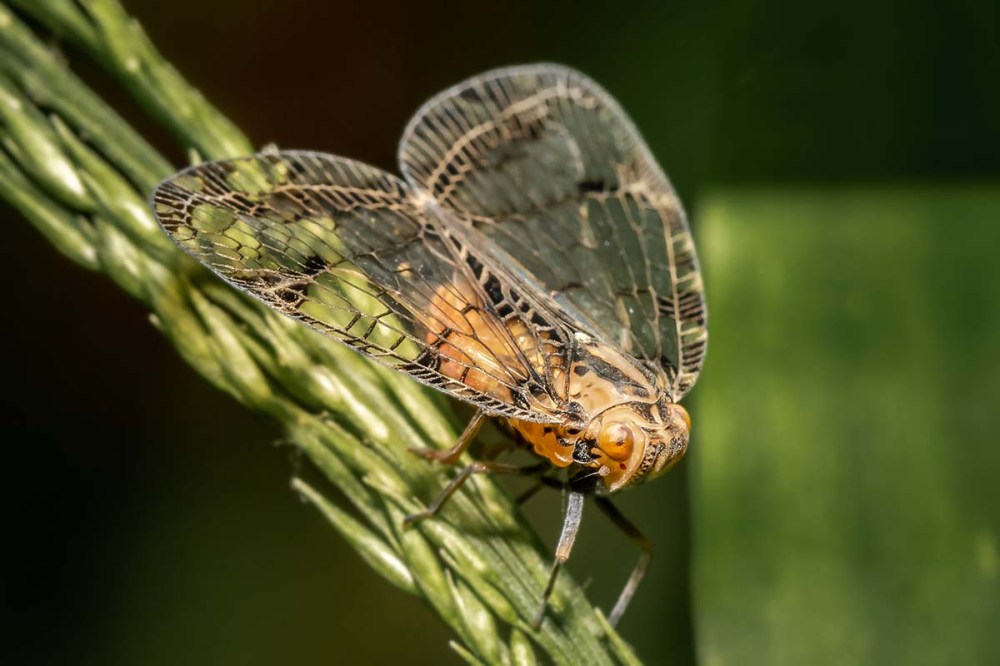
Net-winged Planthopper, (Bolleyana costalis)
There are 22 families of planthoppers consisting of approximately 12, 500 species. Despite their method of feeding, very few of them are vectors for plant borne diseases and are not especially known as agricultural pests.
Biodiversity Most Ordinary: Better Red Than Dead
Not too far from the Net-winged Planthopper I found another puzzling creature. My initial thought was that this is a Hemipteran nymph, probably Heteroptera but as to what family I do not know.
What caught my eye was the fact that this nymph was colored fiery red and I found it on a bright red Heliconia flower. This invites certain questions. Red is a commonly found color used by plants for their flowers in a tropical rainforest. Red is the complementary color to green. It is a very hot color whereas green is very cool color. Red will vividly stand out from a surrounding sea of green vegetation. Many pollinators have acute color vision and will spot the potential food source, (normally nectar), advertised by the plant. The payback is the transference of pollen and therefore the completion of reproduction for the stationary plant.

Flag-legged Bug Nymph
So does the adult bug select for red flowers on which to lay its eggs and the sap-sucking nymph that hatches is red and blends in with its host plant? Might it be that the nymph upon hatching feeds on the plant tissue and takes in the plants red pigments such as carotenes, which it then stores to subsequently give it the matching color? It may well be that is was simply a coincidence and the red nymph just happened to be on a red flower, there are many red heteropteran nymphs that feed on green leaves which defies logic as they then become very visible. But nature has its ways, which unlike the red nymphs on green leaves, is not always obvious.
Biodiversity Most Ordinary: Tales of the Flesh
Flies are distained by most people, and with good reason; they can be both annoying and dangerous. For the most part, flies possess wings, atypical for insects – only one pair of wings. Adult flies are liquid feeders and that embraces just about all liquids, including blood, particularly vertebrate blood. The larvae feed on liquids and solids.
Excellent fliers with unspeakably bad habits, (from a human point of view), and the ability to travel over long distances give the Diptera, (True Flies), a reputation as one of the most serious vectors of human borne disease and pathogens.

Flesh Fly, (Sarcophagidae sp)
Flies require protein in their diet, a first-rate source of which is blood, mammalian blood, human blood. Mosquitoes are probably the most widely know vectors used by blood living parasites as vectors between species and individuals within a species. Mosquitoes are not alone, they are joined by Black Flies, Sand Flies and Horse Flies as bringing nuisance, illness and death to their victims.
This Flesh Fly, (Sarcophagidae sp), was perched on a log in the sun. Flesh Flies could be regarded as a typical dipteran, to look at there is nothing outstanding. They are not particularly large or have strange anatomical features. There are about 600 species of Flesh Flies in the neotropics and to the layman they mostly all look the same.
Because they are common and widespread, their unsavory habit of feeding on carrion and excrement as well as associating with humans points the finger of accusation in being the mechanical vector in disease transmission. Unlike most dipterans Flesh Flies are ovoviviparous, the larvae hatch from the eggs as they are laid. In some cases this may be an open wound in a mammal where the maggot immediately begins to consume the rotting tissue, hence the name Flesh Fly. Who knows what this individual might have been carrying on its feet and liquid feeding tongue but I was never going to get close enough to find out.
There is still no let up in the rainy conditions. The good news is that the days are more overcast than dark and the rain is now falling more as a drizzle rather than a deluge. As with recent weeks the sun has been shining once in a while so hopefully as we move into December the rains will abate and we will be able to say the dry season has started.
Rainforest Diversity – Beetles
The wet conditions have kept me indoors more than I would like. On those occasions that I have been out and about there was not too much animal life to point the camera at. When you read about the diversity of fauna and flora contained within a tropical rainforest you would expect to be surrounded by a non-stop progression of subjects. That is not always the case. However if you persist and concentrate on looking a little more closely at the vegetation then something is bound to turn up.
Beetles are the most numerously named group of animals on the planet. Surely there have to be beetles wherever you look. Well they aren’t as obvious as you might imagine. Many of them are secretive, ground-living or wood-boring insects. Looking diligently at the leaves as I made my way along a sunny path and hoping for at least one or two individuals of any insect to be out I saw a small beetle that I had never seen before. Given that Costa Rica has 47,000 named species of beetle and I would never profess to being a specialist coleopterist, then the fact that I did not know what species I was looking at should come as no surprise.

Long-horned Beetle, (Family: Cerambycidae)
I can generally make an immediate I.D. to family level and that was not hard with this one. The length of the antennae were the give away, the very long length, far longer than the body. This was a small Long-horned Beetle, family: Cerambycidae. This one also had a long pronotum, (the area behind the head), and a very long body. I was guessing it belonged in the subfamily: Cerambycinae. I now had to go and research online to see if I could find the genus and species. Alas, my scrutinizing a great many photographs failed to result in a match but at least I have the image should I find further reference material in the future.
Rainforest Diversity – Fungi
The beetles are matched by the fungi in terms of numbers and also a lack of reference material for the non-specialist to identify them to species level. Many of the biologists working with tropical taxa tend to be specialists. I am more of a generalist and enjoy all forms of life; plants, animals, fungi and no matter whether they are extant or extinct. My areas of specialty are butterflies, reptiles and amphibians. It can be frustrating sometimes when a name cannot be found as that might reveal information about the life-history of the organism and its role in the ecosystem. Essentially it helps establish those links that increase our understanding of the system, what happens if those links are severed and conservation management strategies that would be required to stop the system collapsing.

Hygrocybe sp
So it was that I found a mushroom growing from the side of a rotten tree trunk. I had seen and photographed this species before and, like so many others, had not been abled to identify it to species level. There are 2000 named species of fungi in Costa Rica but estimates of how many species actually exist in this small country are as high as 70 000, so you can see the problem, you may be looking at one of the 68 000 estimated species that have not as yet been discovered.
This specimen was somewhat dried out and partly eaten. The aspect gives a good view of the gills under the cap. Given the features I have to work with I would guess the genus to be Hygrocybe, but I would not be held to that. Within the gills you can also see a fungus fly. These are flies that lay their eggs in the mushroom and when the larvae emerge they are surrounded by a ready food supply.
Rainforest Diversity – Spiders
Spiders are the eighth most numerously named group of animals on the planet. As with the beetles and fungi, reference material is sparse for Costa Rican species. However, this was one I did know. It is not an uncommon spider. They are nocturnal and build very distinctive horizontal webs. It is an Orchard Spider, (Leucauge venusta).
They are not large spiders and can be easily overlooked. But if you get up close you will find it has rather lovely markings. The opisthosoma is patterned with curving bands colored with white, red, yellow and blue.

Orcha)rd Spider, (Leucauge venusta
Orchard Spiders are prone to being parasitized by Ichneumonid Wasps. The wasp finds the spider and injects an egg into its abdomen. The egg hatches and the wasp larva proceeds to suck the spider’s internal bodily fluids. Outwardly this does not seem to affect the spider’s behavior and it continues web building as normal. But then something insidious happens. The wasp larva produces a chemical that allows it to sequester the spiders brain. The chemical changes the spiders web building behavior and it produces a web which is not conducive to capturing insects but rather acts as a protective silken home for the pupating wasp. The zombified spider, now of no value to the wasp, dies. Nature can be both cruel and fascinating at the same time.
Rainforest Diversity – Butterflies
For someone passionate about butterflies I am in the right country. Rainforests cover 6% the total land surface of the Earth and yet contain an estimated 50% of the worlds biodiversity. Costa Rica, with only 0.3% of the planets terrestrial area is estimated to house 5% of the world’s total biodiversity. The Osa Peninsula in the south west of the country is one of the most biodiverse localities in Costa Rica. There are a lot of butterflies here. I have recorded approximately 400 of the 1250 species to be found in this small Central American Republic, that is 32% found at Cabo Matapalo, the tip of this tiny piece of land sticking out into the Pacific Ocean.
Even here on Cabo Matapalo there is a large diversity of habitat and different butterflies prefer different conditions. Many of the butterflies live up at canopy level and are beyond daily recording techniques. There are butterflies that prefer open sunny gardened areas, some can be more commonly found along forest edges. Then there are those presence will only be recorded in the gloomy and shadowy world that exists beneath the canopy, some at higher levels and some always hugging the ground.
I have nothing against bright, gaudy coloration but my liking is for more cryptic and subtle forms which when examined close up are every bit as beautiful as their showy cousins. Among the more subdued colored butterflies are the Browns or Satyrs belonging to the family: Nymphalidae, subfamily: Satyrinae. The Satyrinae are notable for the number of eyespots on the underside of the wings. The ground colors are browns and grays patterned with ochres and umbers.
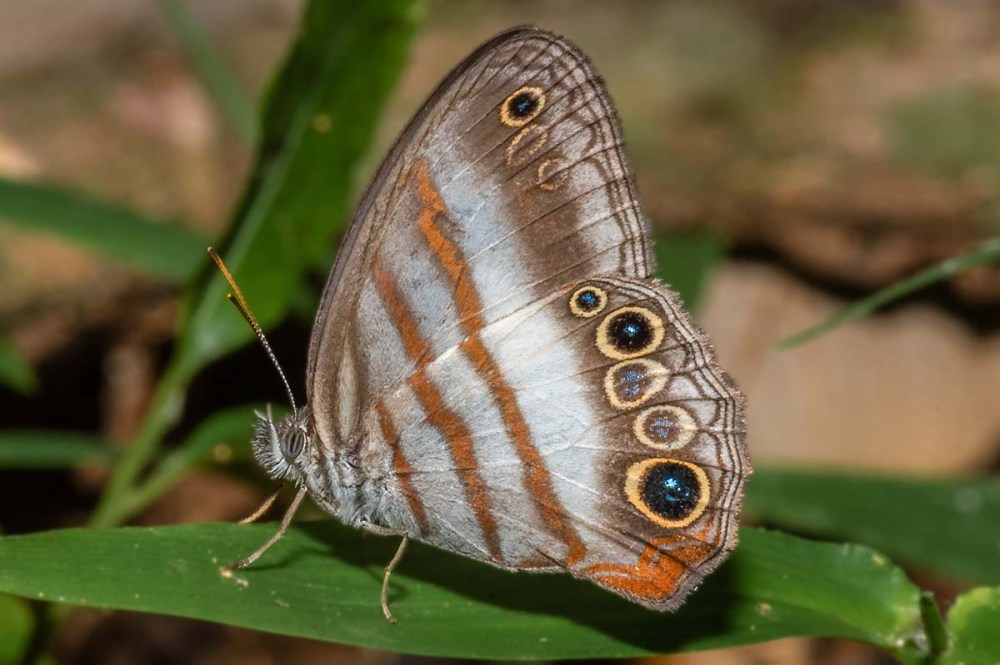
Two-band Satyr, (Pareuptychia ocirrhoe)
The Two-banded Satyr, (Pareuptychia ocrirrhoe), has white dorsal wing surfaces and a bouncy flight close to the ground which gives it a flickering appearance. I found this one flying along the forest edge on a very overcast day. They respond quickly to movement so you have to approach slowly and deliberately in order for them to stay perched.
The Two-banded Satyr is normally found singly. The larvae feed on grasses, (Poaceae), and the adults feed on rotting fruit and fungi, a diet that may account for them living longer, (several weeks), than other butterflies, (several days).
November is upon us. The wet season continues, relentless heavy rain falling if not all day then at least part thereof. One day last week over 14 inches of rain fall in an overnight deluge. The following day the forest trails were more akin to newly formed streams, the water flowing downhill until it reached a point where it could tumble into the main creek that runs through the grounds, swelling its volume and increasing its velocity to that of a raging torrent. There have been some dry, sunny days and if the weather continues its normal pattern then progressively as we move through the month the number of rainless days should increase.
I have been away for a month and upon my return, as with each and every year, the first thing I hear is the call of the Summer Tanager, (Piranga rubra), a migrant which has spent the summer in North America. Not much has changed in the area while I was away. The resident wildlife can still be found without any effort. The White-nosed Coati, (Nasua narica), populations are growing at a steady and sustained rate. I have never seen as many wandering the grounds as I do now. The solitary males are normally bold creatures, but the females tend to be shy and retiring. Now, however, the females and their young will allow you to approach very close without scurrying off into the shelter of the trees as they did in the past.
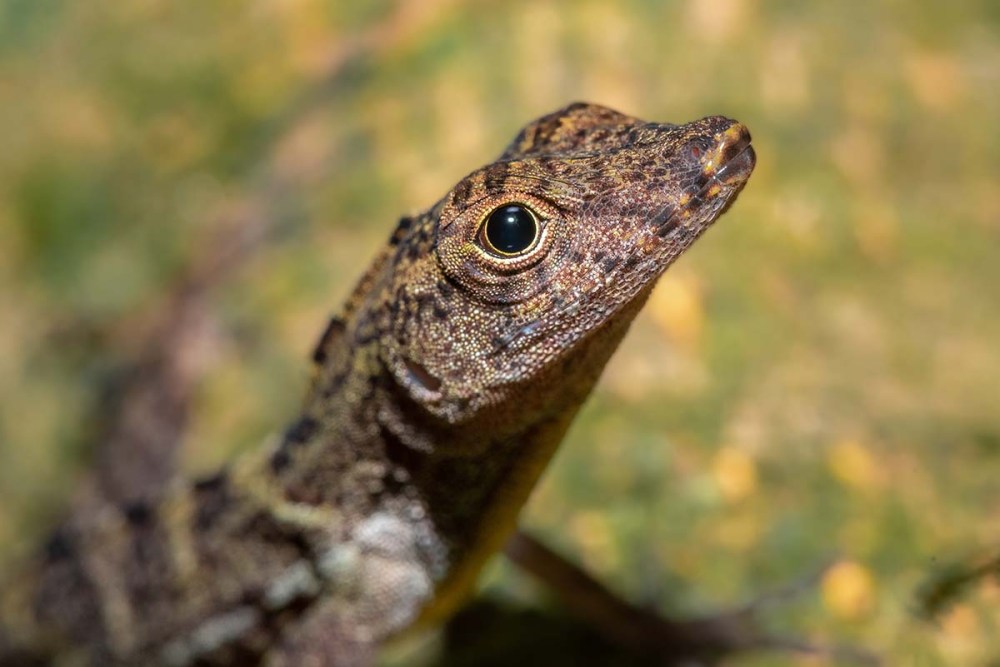
Golfo Dulce Anolis Lizard, (Anolis osae)
The wet conditions have allowed the amphibians to continue their courtship and breeding. There are not so many egg masses present as in the main breeding period, (May – July), but there are still several species spawning on a nightly basis. Feeding on the frog eggs are the Cat-eyed Snakes, (Leptodeira septentrionalis), which can be found every night by the pond. The ever-present anoles of several species can be seen in the forest. The commonest and most obvious is the Osa Anole, (Anolis osae), with its bright orange dewlap. If one male is signaling to another to leave his territory then you can’t miss that fiery flash of color against the dark background.
Ants Are Everywhere
Ants are ubiquitous insects in the forest. On the trees you will see lines of Tiger Ants, (Camponotus sericeiventris), walking in line, foraging for food. They receive their name from the black and yellow coloration rather than an aggressive nature. In the lawns you would be well advised to avoid stepping in those small powdering mounds of earth that betray the presence of Fire Ants, (Solonopsis sp), living just beneath the surface. I have never known anything so small cause so much pain as the fire ants. The problem is that they are so small you don’t know you are covered in them until they start to bite and they all do so together. It would be almost impossible to miss the presence of Leaf-cutter Ants, (Atta cephalotes), in these forests, whether it be descending the tree trunks with freshly cut leaf fragments or seeing lines of ants moving as a green river, snaking across the forest floor as they make their way back to, the nests with, what essentially is composting material for their fungus gardens. Leaf-cutter Ant nests occur every 100 meters or so in whatever direction throughout the forest and can easily be identified by the large waste tips of excavated material marking the nests’ peripheral boundaries.
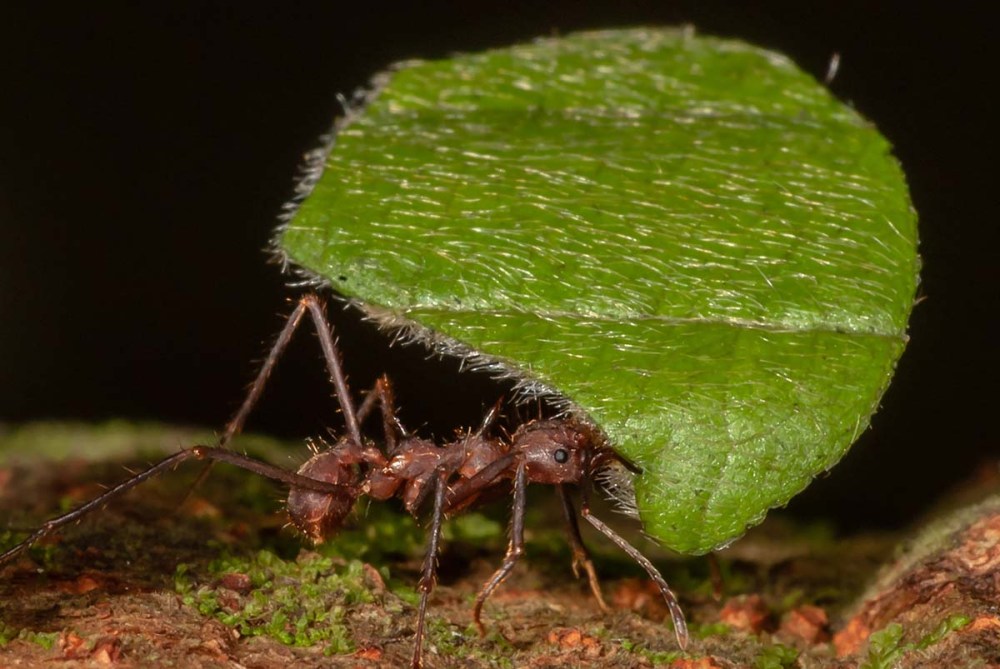
Leaf-cutter Ant (Atta cephalotes),, media caste carrying leaf fragment
Army Ants: A Living Wave of Black Death
It is a warm day, the rain has stopped, the sun is shining and you are quietly walking through the forest, binoculars strung around your neck and camera in hand. The air is still and there is little sound bar the occasional call of a bird here and there and the soft white noise of calling insects which is not too intrusive. You walk in a state of reverie, not thinking about anything in particular, your eyes scanning the vegetation for small subjects to photograph or watching for movement that may indicate a bird or mammal is moving across your path. It is a day for enjoying your surroundings and contemplating the life contained within. You are blissfully unaware of the carnage being carried out in the forest ahead.

Army Ants, (Echiton burchellii)
As you make your way forward you start to hear more birds calling. Some of the sounds you are familiar with; a Black-hooded Antshrike, (Thamnophilus bridgesi), Bicolored Antbirds, (Gymnophythis leucaspis), and Chestnut-backed Antbirds, (Myrmeciza exul). This seems as if it might provide some good photographic opportunities so you make sure the camera is ready with the correct settings. Now some other birds fly past you and land on the tree trunks, most of them a variety of treecreepers; Streak-headed, (Lepidocolaptes souleyetii), Tawny-winged, (Dendrocincla anabatina), and Ruddy, (Dendrocinclo homochroa). The bird calls are increasing in intensity, excitement and volume as you make your way to where they seem to be congregating. As you approach you can see them briefy dropping from the vegetation to the ground and back up again. There is another sound, a hum which pervades the air. Having left your dreamlike state and become more acutely aware you see that you are surrounded by flies buzzing everywhere. You see one or two Gray-headed Tanagers, (Eucomectis penicillata), amongst the mixed bird flock, the presence of which along with the flies provide the clues as to what is happening. Finally you hear, a sound like softly falling rain and yet there is not a cloud in the sky. From about 5 meters in front of you and advancing rapidly towards you like a sheet of black polythene being pulled across the forest floor is a foraging front of Army Ants, (Echiton burchellii); a living wave of black death.
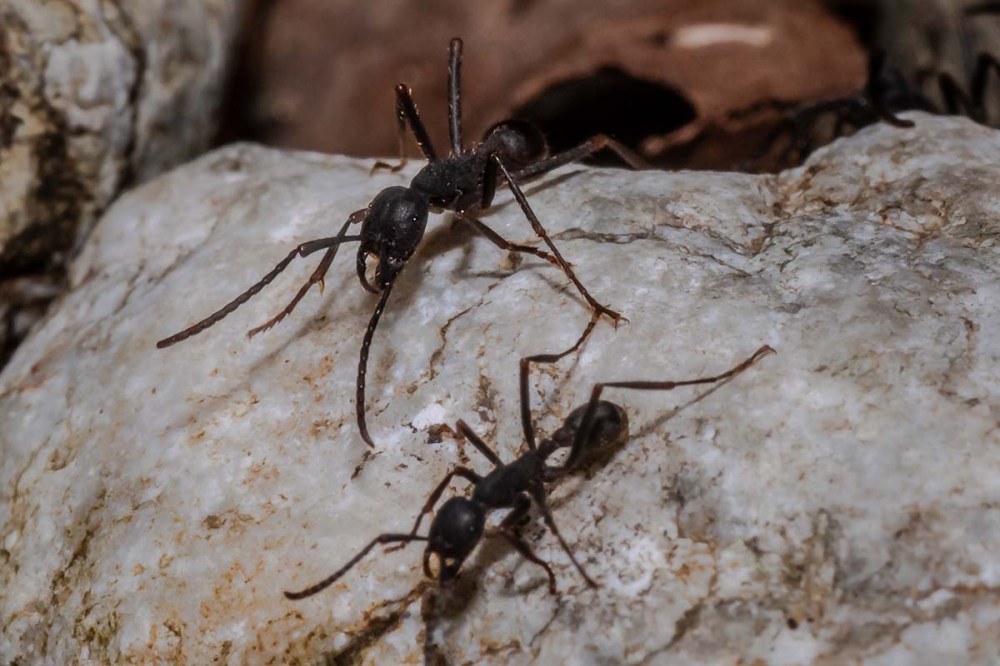
Army Ants, (Eciton burchellii), on the move
The feet of thousands of miniature assassins moving as one across the dried leaves give the illusion of rain falling. You stand dumbstruck by the scene playing out in front of you. As the procession of annihilation moves closer you can see down by your feet beetles, cockroaches and crickets running for their lives. These are the lucky few. The killers are insatiable. Any small creature unfortunate enough to caught in their unrelenting path will be overwhelmed, stung to death, and then decapitated, dismembered and disemboweled. The wickedly sharp mandibles of the army ant hunters slash and cut through exoskeleton, muscle and connective tissue. The victim’s mutilated body fragments are then carried away by the mindless insect ghouls to provide a feast macabre for the larvae. As fascinating to witness as this bloodbath at the macro level is, you had better move. The ants are now crossing the path all around your feet. You might be too big for them to tackle, but the long stinger and virulent toxin can cause a lot of pain.

Army Ants, (Eciton burchellii), carrying dismembered spider leg
For those insects capable of flight and able to escape the ravaging mandibles of the ants, the danger is not over. The birds were attracted to the ant swarm to take advantage of the free meal they provide by flushing insects from their hiding places. Gray-headed Tanagers are obligative followers of the army ants. Wherever they are, you will find the tanagers. The flies are there for the same reason. These are Coffin Flies, (Phoridae sp). When an insect attempts to escape by taking flight, the parasitic phorid fly swoops in, lays an egg and flies out again. The eggs will hatch and the grub will eat the victim.
Army Ants are one of the major predators in the forest. They rank alongside Boa Constrictors, Harpy Eagles and Jaguars as one of the top of the food pyramid predators in the forest. They are a nomadic ant and they have to be nomadic because being such a super-efficient predator, should they settle in any one area for any length of time, they would deplete it of all small forms of life very quickly.
They have 2 three week cycles; a nomadic stage when they move in a flowing column of ants, the queen travelling with them, until they find a new hunting ground. They do not construct a nest, they make a bivouac, generally at the base of a tree, which is a huge ball of ants held together by the interlinking of legs. The queen moves to center and swells up. She starts to lay approx. 60, 000 eggs per day. When the eggs hatch and the larvae emerge, the emit a pheromone which elicits a hunting response from the other workers. They then move through the forest in a front anything up to 60 feet, (20 meters), across and take all small forms of life in their path: insects, small frogs, small lizards, small snakes, fledgling birds, if it is there then they will have it. Once it has been butchered into small pieces, these are taken back via feeder columns to the bivouac to feed the larvae. When the larvae pupate, the hunting response is switched off and they return to the nomadic stage making their way through the forest once again.
A New Assassin
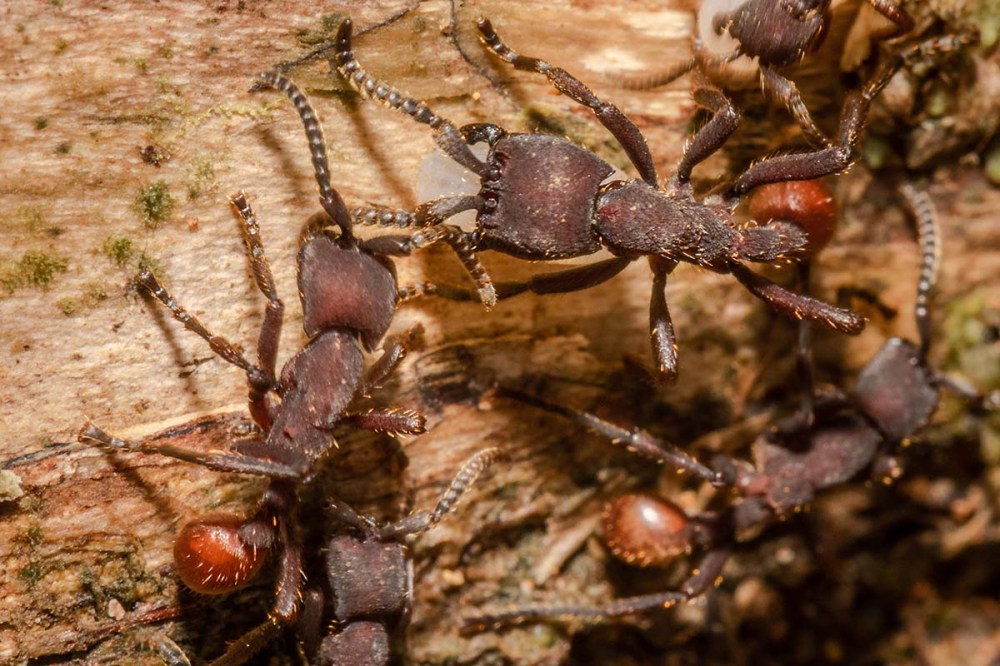
Army Ants, (Nomamyrmex sp), taking larvae from a Leaf-cutter Ant nest.
There are many species of Army Ant and the species described above is the most commonly found in the area Echiton burchellii. Last week I found a species that I had never seen before. As well as slaughtering prey items on the forest floor, army ants will also enter the nests of other ants and take out the eggs, larvae, pupae, workers and queen. The one ant they fight shy of taking on are the Leaf-cutter Ants. There may be several hundred thousand in an army ant colony, there can be up to 8 million in a leaf-cutter ant colony. The soldier leaf-cutters are huge and equipped with razor sharp mandibles. They are programmed to fight to the death. The army ants would lose so many of their own numbers if they were to raid a leaf-cutter ant nest. Even if they come across them on a trail they will not interfere with them.

A rare sight, Army Ants raid Leaf-cutter Ant nest
It was to my surprise therefore when last week a watched for the first time an army ant raid on a leaf-cutter ant nest. Luckily I had the camera in my hand and found a place to lie down and take photos. On this occasion the leaf-cutters seemed to be helpless to stop the nest being ransacked. When I downloaded the images and looked at the images I did not recognize the species at all. Despite their distinctive flat, square heads, extensive searching produced no I.D. Eventually I found one photo and some information. The genus is Nomamyrmex and it contains two species. I am not sure which one I had been watching but I was happy to have witnessed an event I had never seen before being carried out by an ant I had never seen before and had the photos to prove it.
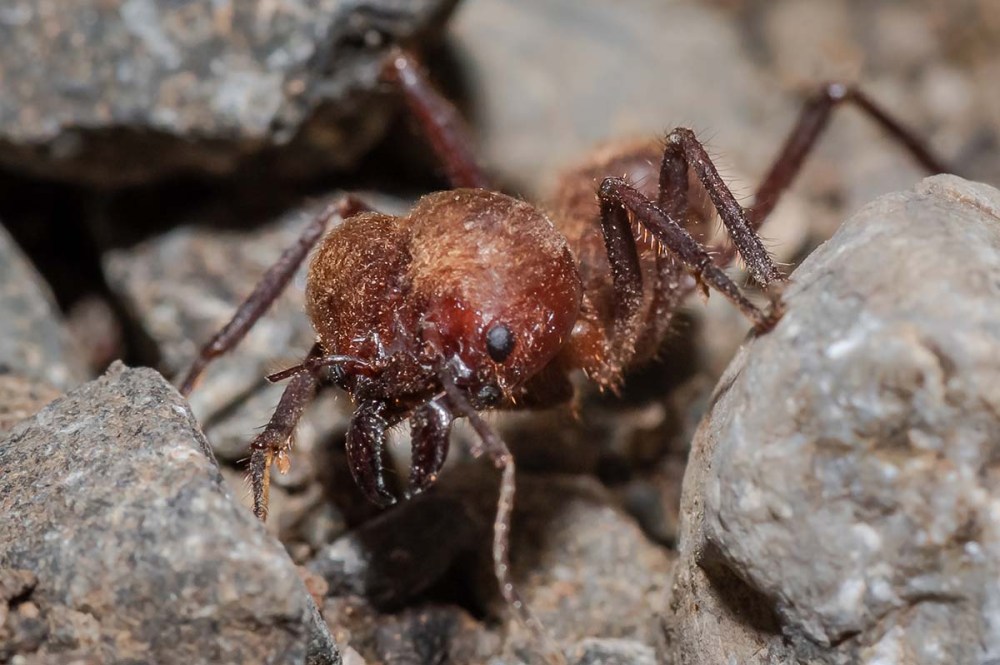
Leaf-cutter-Ant, (Atta cephalotes). Maxima caste
Now the weather has taken a significant change. The rains that are expected to fall in September have started in earnest. The rain is now falling all day and on most days. This is good news for the frogs and this year the breeding continues on without a drop in intensity. Every night there are large numbers of calling males. The females are obviously responding because every morning there are lots of freshly spawned eggs.
After 17 years of data collection for my study, “Using amphibian and butterfly populations as a measure of environmental health”, I have decided to call it a day and now have to sit down and analyze the data. Essentially I have been collecting data on population dynamics of butterflies and amphibians as well as recording daily weather conditions. I look at changes in butterfly populations measured against temperature and amphibian populations measured against precipitation. Over seventeen years the temperatures have continued to rise in a linear fashion and the number of butterfly species have dropped dramatically. I now have to try and figure out why.
Butterflies in the Sun
Due to the constant rain and the trails running like streams, I have not been able to spend as much time outside as I would normally wish. However, on the one day I did manage to get out and take some photographs I was rewarded with a mixed bag of goodies of which only one was new to me.
One morning the sun was shining and the butterflies were taking advantage of its warming rays. The Lantana camara bushes are always a big nectar draw for the butterflies and this day proved to be no different. Although there were nowhere near the number of species found during drier periods of the year there were enough to try and take a few shots.
One very small but distinctive butterfly that I have a particular liking for, (I don’t know why), is the Tropical Checkered Skipper, (Pyrgus oileus). It is a fairly common skipper with a wide geographical distribution from southern North America and through into Costa Rica. At a distance the black and white checkered pattern make it stand out against the green of the grass where it is normally found flying close to the ground. When seen close up the wings and body are covered in a grey/blue fur. The females tend to be a darker overall color. The caterpillars feed on plants in the family: Malvaceae, of which there are several species growing in abundance locally.
They belong in the family: Hesperiidae and the subfamily: Pyrginae or Spreadwing Skippers due to their habit of basking with the wings wide open. There are approximately 50 species in the genus: Pyrgus and they can be found throughout Europe, Asia, North, Central and South America. You are more likely to find Tropical Checkered Skippers in open sunny locations which is where I found this one.

Tropical Checkered Skipper, (Pyrgus oileus)
Feeding on the nectar of the same patch of Lantana was yet another Spreadwing Skipper but one which looked completely different to the Checkered Skipper. This was a Plain Long-tailed Skipper, (Urbanus simplicius), notable for the two long tail-like extensions of the hind wings. There are several species of Long-tailed Skippers in the immediate area but each one has distinctive markings to the wings. The dorsal surface of the abdomen and the wings are covered in metallic green hairs. Again it is a widespread species ranging from southern North America, down through Central America and into South America. The larvae feed on leguminous vines of which there are many species growing locally. In North America it is sometimes considered a pest as it feeds on commercially grown beans.
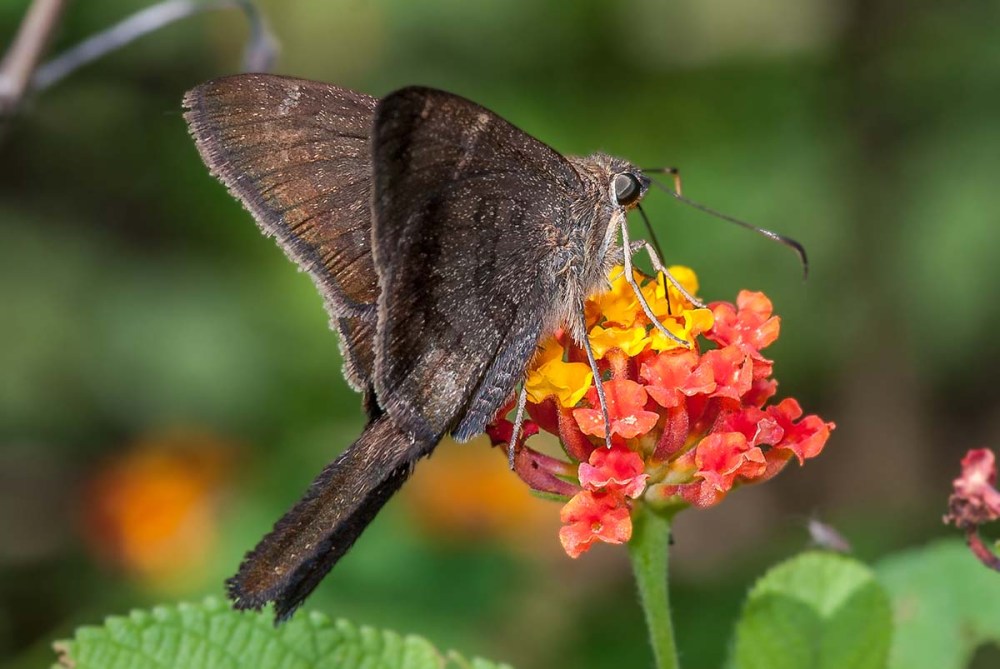
Plain-Longtail, (Pyrgus simplicius)
This individual can be seen using its proboscis to probe for and suck nectar from the Lantana blooms. One of the changes I have documented over the past 17 years is the progressive increase in annual average temperatures. One of the impacts this may have on butterfly populations is with increasing temperatures there will be increasing evaporation of the nectar. This in turn causes an exponential increase in nectar viscosity. We could end up with a situation whereby if the temperature increases to the point where the nectar is too viscous for the butterflies to suck up, then they may well not be able to feed, bringing about starvation, death and a collapse in butterfly numbers. This is one of many variables I have to take into consideration when looking at the fact that we have had a 35% decline in butterfly species over the past 17 years.
Sweat Bees: Burnished Metal
While watching the butterflies flit back and forth, only stopping momentarily to take a feed of nectar, I noticed a tiny metallic green insect, only about 10mm long. It was on top of a leaf at eye level and not moving. It was striking in that the green was very reflective, it looked like a piece of metallic foil. I was looking at a Sweat Bee. I have only ever photographed one in the past so if this one did not move then here was a second opportunity beckoning. I slowly lifted the camera and got the shot but as I moved my position for a head on photo it took to the air and disappeared.
Sweat Bees are solitary bees of the order: Hymenoptera, which includes bees, wasps and ants amongst others. They belong in the family: Halictidae. The burnished metallic green certainly has a jewel-like quality. The refraction of light produces the spectacular metallic coloration, similar to the iridescent blues of the Blue Morpho butterflies. In this case it is the multi-layered waxy cuticle of the bees exoskeleton that produces the refraction. There are over 2,000 named species of Sweat Bee and they are found in most parts of the world.

Sweat Bee, (Augochloropisis sp)
The name Sweat Bee refers to the fact that they will land on your perspiring skin to suck up the sweat for the salt it contains.
They are solitary bees and usually nest in the ground. The female creates a waxen cell then mass provisions it with pollen and nectar. An egg is laid and the cell capped so the larva can develop within. Once fully grown, it pupates, and finally emerges as an adult and leaves the mothers nest.
A Collection of Queens
A wasp nest that I have been walking past over the past month or so has been not only gradually increasing in size but is now populated by more adult wasps tending it. It is the nest of one of the Social Paper Wasps, (Polistes sp). The original queen had created a few cells beneath a leaf in each of which she laid an egg. The eggs hatched, the larvae she provided with a food of chewed up insects until they were large enough. She then capped the cell of the now pupa and waited for it to emerge. The new wasp is one of the original queen’s offspring and like their mother they are equally capable of mating and reproducing.
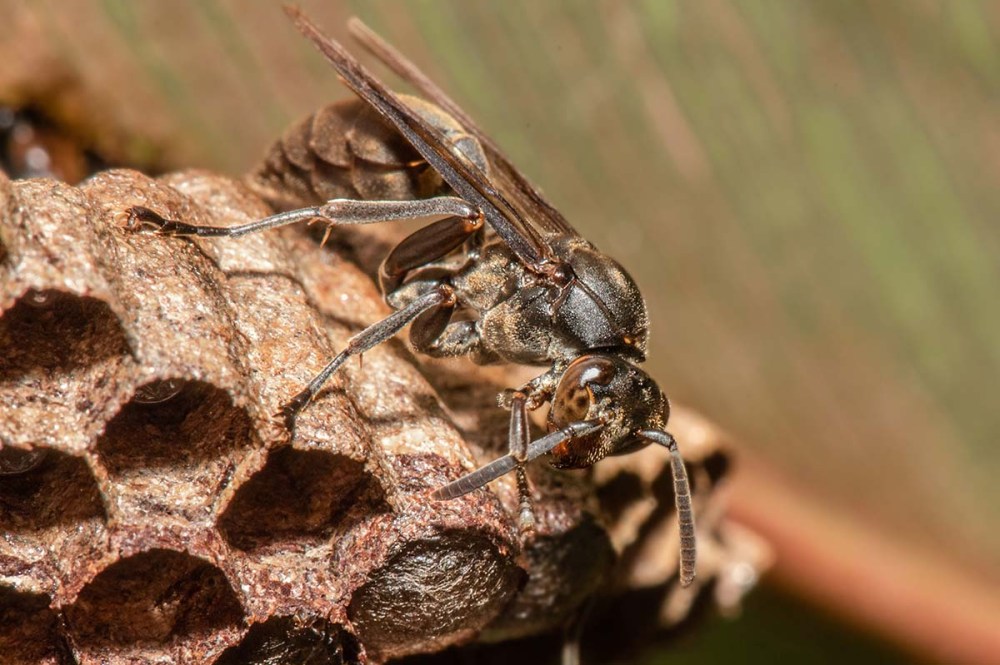
Paper Wasp, (Polistinae sp). Dominant female on nest
To begin with they help with the nest, building more cells, tending the larval siblings, foraging for food and helping the nest to increase in size. The cells are constructed from masticated vegetative material. Prey is caught and chewed up for the larvae to feed. The sting is only used defensively. They will attack any potential predator that approaches too close. So, my approach was one of great stealth. I took a few took a few exposures but the flash was beginning to antagonize them and one took flight and started buzzing around my head which was my cue to slowly back off and leave them to their business.
The other females usually have reduced ovarian systems but dominance of the original queen is not always assured. Fights break out and a new queen can become established within the hierarchy taking over the major reproductive role. When the male wasps emerge, they may stay on the nest for some time before leaving.
The weather is beginning to change. There are now more rainy days with brief intervals of sun, generally shining in the morning. Most of the nights are wet, with the rain beginning in the early hours of the evening then continuing through till dawn. The rain is not heavy but it is constant. This will now be the pattern until mid-November. The opportunities to get out and take photographs is going to become more and more limited as the days and weeks go by.
Ogre-faced Spider
Sometimes you just have to be lucky and find yourself in the right place at the right time. Many years ago I had taken some photographs of a particular species of spider and since then had been hoping to see this species again to get a close up of one of its startling features, the eyes. I have come across it several times over the years but, unfortunately, never when I was carrying the camera. Last week my luck changed and I found one without actually looking for it and I did have my camera in hand.
The spider in question is an Ogre-faced Spider, (Deinopis sp), of the family: Deinopidae. Once you see the spider in close up then the reason for the name will be revealed. Those two large, forward-facing eyes give the appearance of a mythical ogre staring at you.
The Ogre-faced spiders are not typical orb-weavers, they belong to a group known as lace-web weavers and have evolved a different means of employing silk to catch prey. There are only 57 species of Ogre-faced spiders but they are found throughout the tropics. They have long legs and a long abdomen, (opisthosoma). If they do move, it is slowly and deliberately. The coloration matches the tree bark on which they are commonly found hanging in a head down position. During the day they lie flat against the tree to avoid being seen. But as the sun sets they move into position and set about constructing the ingenious part of its prey capturing trap which is held between the front two pairs of legs.
These four legs have a dry silk frame strung between them. Attached to the frame is a net made from sticky elastic silk. An unsuspecting prey item passing below the spider is in for a nasty surprise. The spider, connected by a dragline drops and opens the front four legs which extend the net. It is dropped onto of the victim and when the legs are drawn together again the net closed and ensnares the spiders next meal. The web is shaken a few times to ensure the prey is completely enmeshed, all the while the spider is wrapping in more silk from the spinnerets and continually biting its prey to inject the venom. The secured and now deceased prey is held in the palps while the spider feeds and at the same time constructs a new net ready for the next meal to arrive.
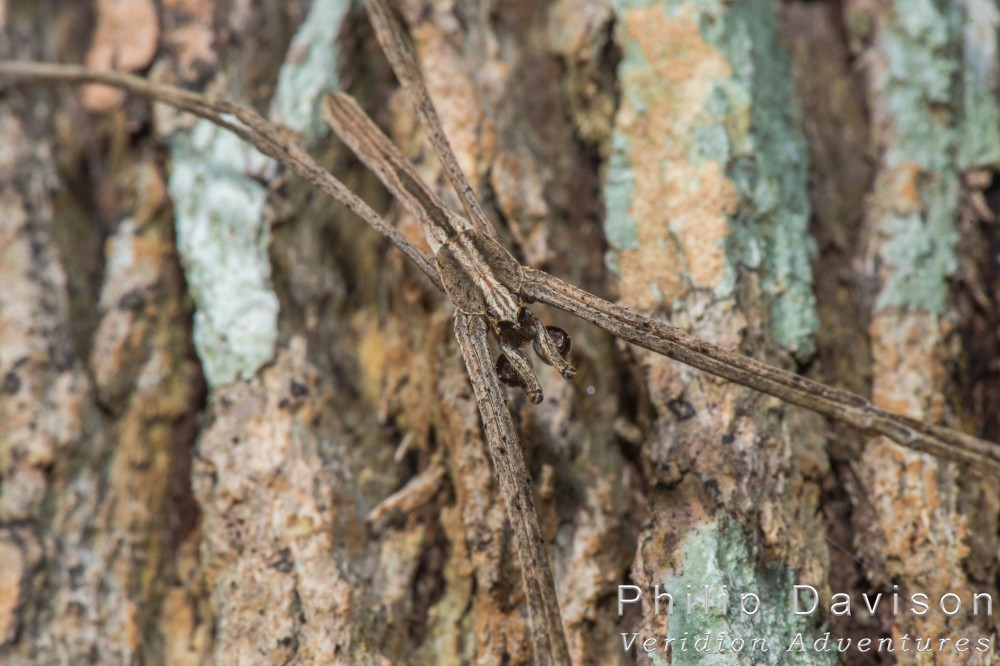
The long-legged, long-bodied Ogre-faced Spider
The feature I was interested in were the eyes. At 1.4mm in diameter, these forward-facing eyes are the largest simple eyes possessed of any land invertebrate. The eyes have an equivalent camera f/stop of 0.6 which enable them to see very well in dark conditions, the time when the spider hunts. This, combined with retinal receptors capable of absorbing the smallest amount of ambient light, 2000 x more than other spiders, means they can hunt in, what to you and I, is total darkness. You can’t see the spider but the spider can see you. Also, this one was a male as can be seen from the enlarged pedipalps under the front of the head. These are used during spider mating.
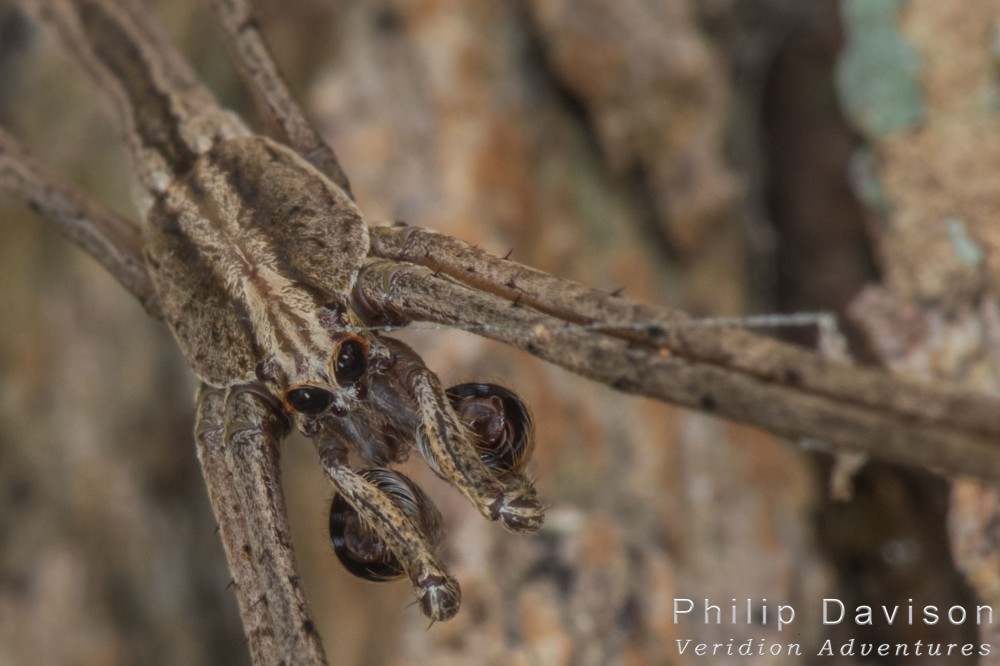
Now you can see those eyes and the features that give it the name; Ogre-faced Spider
Weirdness on the Web
It has been a spidery kind of week. When I was out walking the trails I noticed a small web strung across the path with what I first thought was a small spider removing the papery veil of a Jacaranda seed that had landed there. In the past I have seen various orb-weavers cutting the silk securing an unrequired piece of material that had land in the web, hold it out with their legs until free of the web and let it drop to the ground. Not too far down the same trail I saw a similar thing so I decided to take a closer look. The spider itself was very small and with the naked eye it looked strange, I had not seen this species before and could not quite make out the form. Something just wasn’t right.
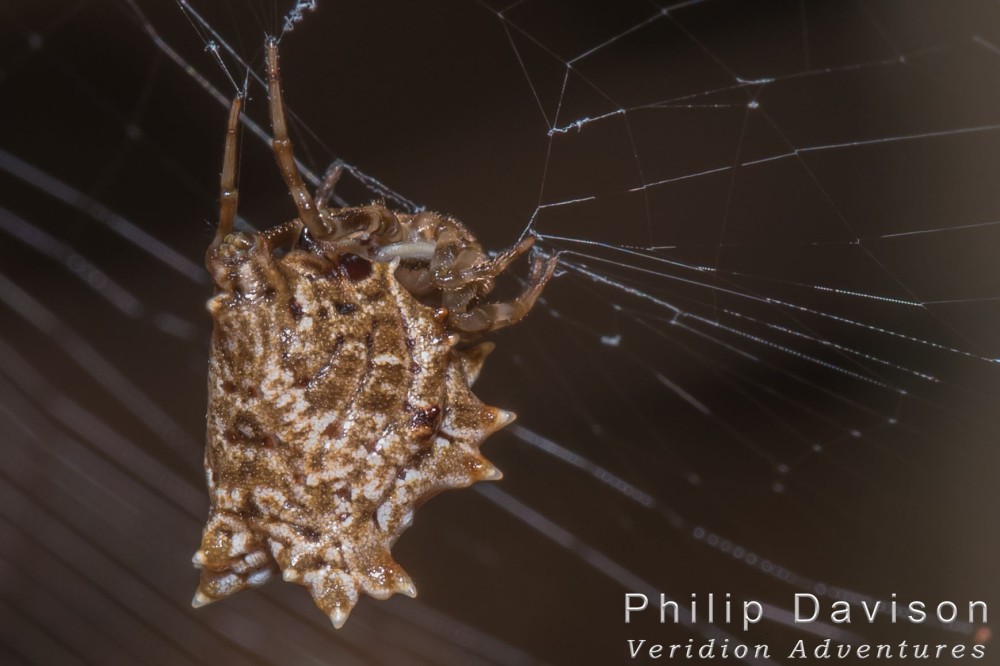
Spiny Micrathena hanging from web, viewed from behind
I took several photographs and looked on the camera screen. The body of the spider was unlike any I had previously seen. The abdomen, (opisthosoma), was drawn up dorsally and expanded laterally. It was covered in a series of fleshy, thorn-like protuberances. I was looking at a Spined Micrathena, (Micrathena gracilis). During the course of the day I found 3 of these spiders, which is strange because I had never seen this species before. Later, when back online and researching more information, I learned it is quite common and widespread. Oh well, new for me and happy to have finally made its acquaintance.
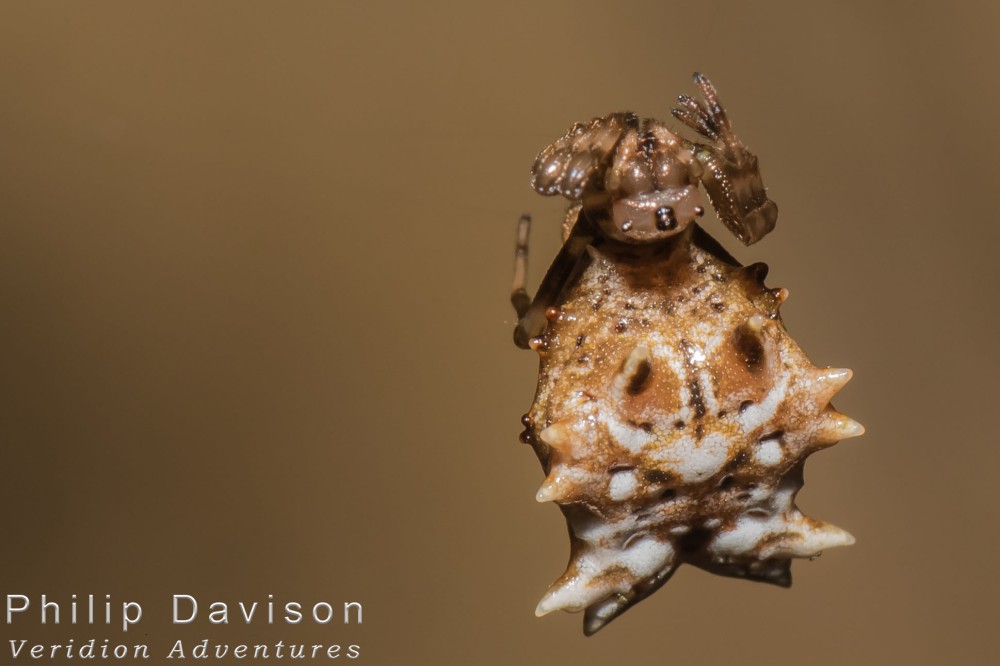
Dorsal view of Spiny Micrathena Spider
Only a few meters down the trail from where I photographed the Spined Micrathena I found another web traversing the path at about 6 feet above the ground. Sitting in the center was yet one more spider that I was unfamiliar with. I knew it was one of the Spiny-bodied Spiders, of which I have found a variety of different species over the years. Unlike Micrathena gracilis above, most Spiny-bodied Spiders are brightly colored and elongated with spines and thorns projecting from the body, sometimes giving them an arrow-shape. I knew this was a Micrathena, the body was long with black centered red spots on a yellow background and with only two more fleshy spines pointing backwards from the abdomen. Extensive searching failed to produce a name for this species. So two new spiders in one day and within several feet of each other.
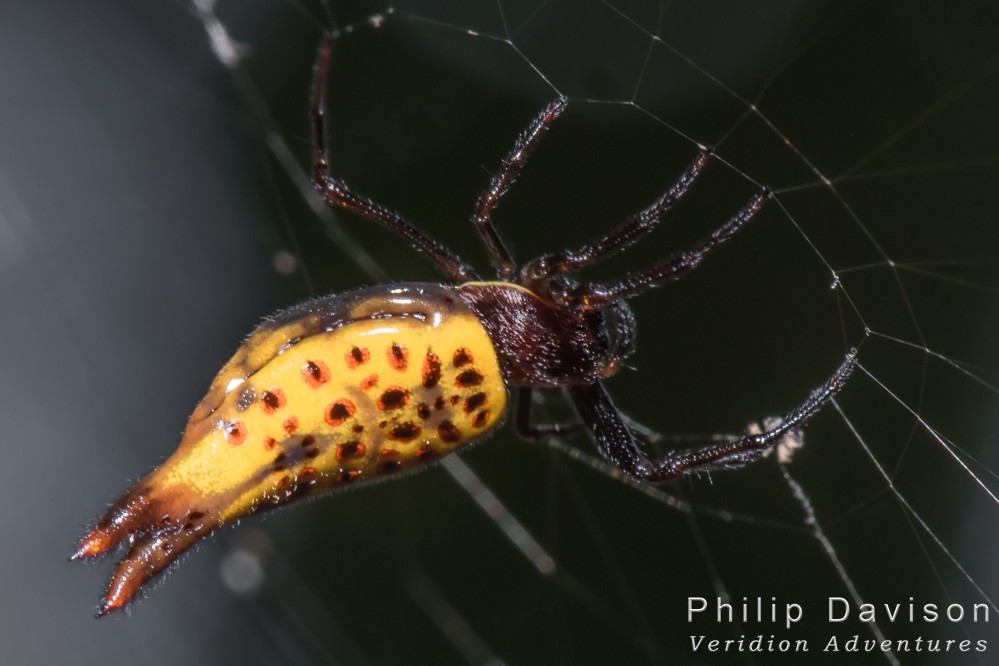
Strange Spiny-bodied Spider, (Micrathena sp), awaiting identification
Finally I noticed a small web strung not too far above my head in the open garden area. In the center of the web was a small brightly-colored but very distinctively spider. The abdomen was vivid lemon yellow with a series of black spots drawn out sideways into an oval shape bearing ferocious looking thorns around the edge. This was another Spiny-bodied Spider, (Gasteracantha cancriformis).
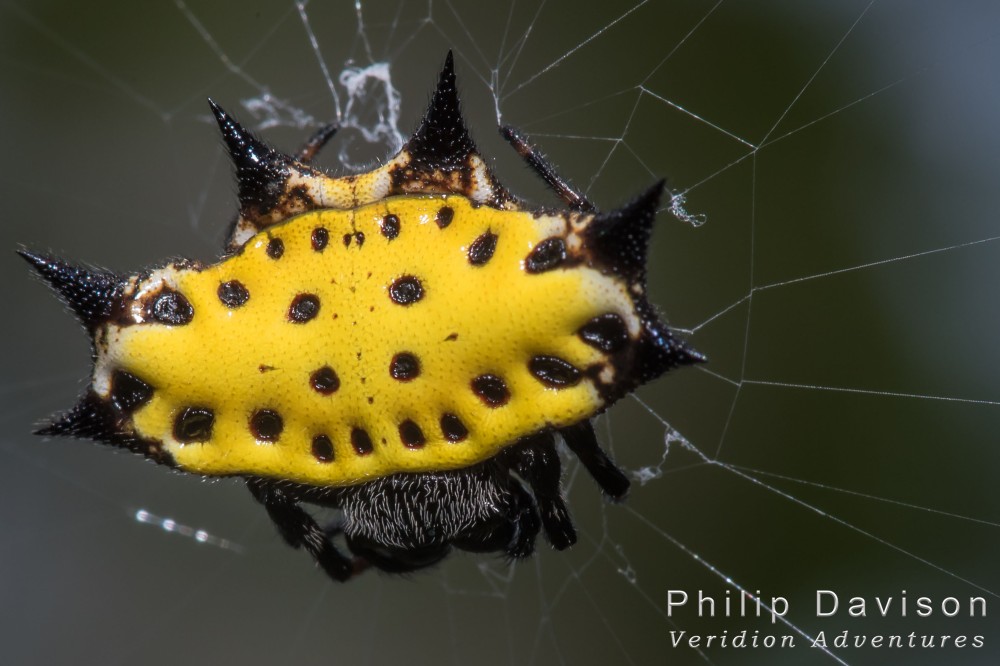
Spiny-bodied Spider, (Gasteracantha cancriformis)
They are a very common species but are so small that you generally don’t notice them until you walk into the web. To avoid this situation the silken strands securing the web are flocked with fluffy pieces of silk to make it more obvious to larger creatures. They come in various color, yellow, white and red being the commonest. They are very widespread, being found from southern U.S. to northern Brazil and everywhere in-between including the Caribbean Islands.
It is a very short-lived spider; the females die after producing an egg cocoon and the males die a short time after mating. In certain locations it is another spider that has a reputation it does not deserve. Some of the native populations regard it as being very venomous. It is quite harmless.
Philip Davison Is a Biologist, Writer and Photographer Based in Costa Rica
There is a small photographic group staying at the moment and they echoed the sentiments of the group that was leaving as they arrived, namely, in the one afternoon and morning that they had been on the Osa Peninsula, they were stupefied by the sheer number of animals they were seeing. I gave them some advice as to where they should go to photograph the various subjects they were after, left them to it and off I went to walk my transect.
Add a little sunlight to warm the air and out will come the butterflies. They are inactive during periods of inclement weather but today they appeared almost spontaneously with the sun. It was nice to see three species of Sulfur; medium sizes yellow butterflies that grace the open garden areas.
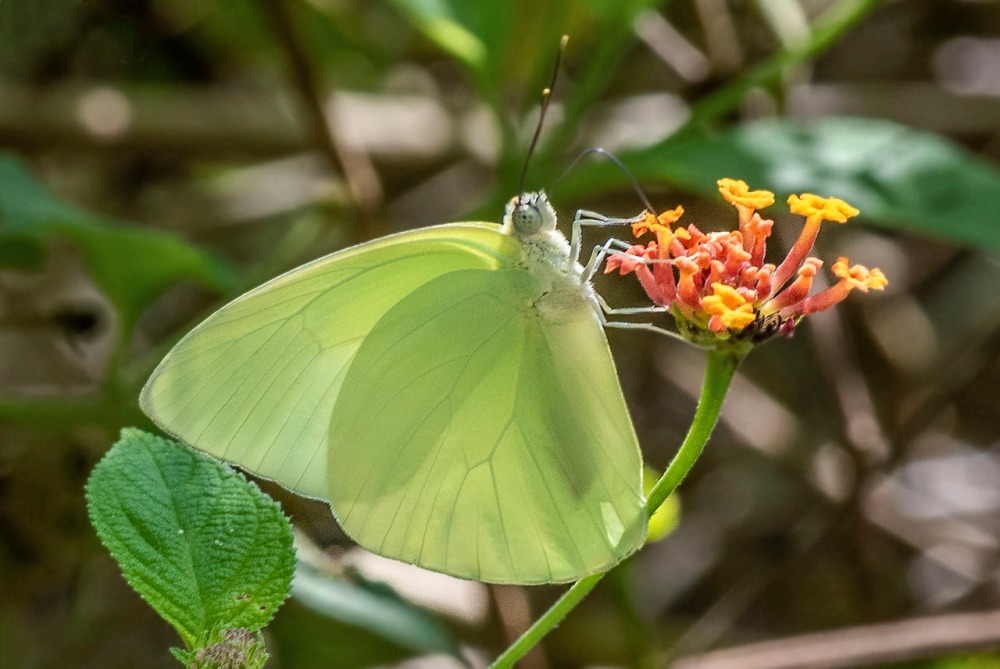
Cloudless Sulphur, (Phoebis sennae)
On the forest trail, I knew there was an Agouti, (Dasyprocta punctata), and White-nosed Coati, (Nasua narica), nearby because of the fresh tracks on the ground. For the same reason, I knew there was a herd of Collared Peccary, (Tayassu tajacu), not too far ahead. As I walked up a muddy incline, listening to the soft trilling call of a Black-throated Trogon, (Trogon rufus), my attention became redirected to a clacking sound that I know very well. Up on top of the ridge were the peccaries, the males snapping their teeth together in a signal of alarm. Peccaries, like the coatis, have exceptionally bad sight and hearing but an excellent sense of smell. If you are downwind of them they quite often have no idea that you are there. If you are upwind of them they will pick up your scent immediately. And so it was with this herd of about ten or twelve, they knew I was there, but also probably had no real fear as they have not been hunted on the grounds for the past ten years. As I continued to walk up the hill they just walked off into the forest to continue about their business.
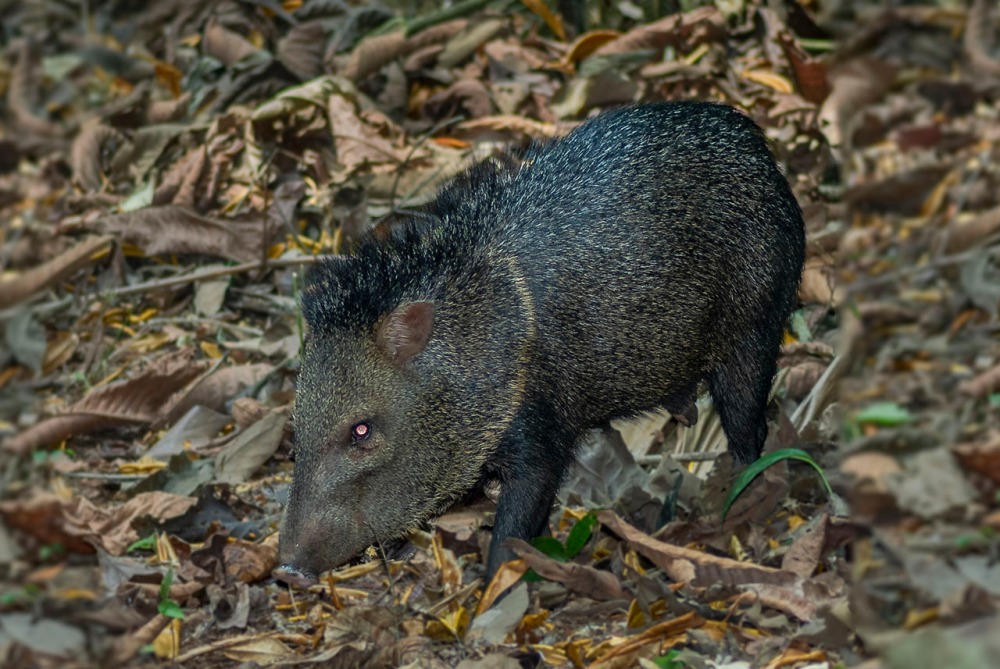
Collared Peccary, (Tayassu tajacu)
There were two other noteworthy sightings today, one a new species of butterfly and the other an occasionally seen species of damselfly. The butterfly was one of the Firetip Skippers, Myscelus assaricus, the forewing divided between orange and black in color with a broad white band. The most eye-catching feature though is the fast “buzzy” flight so typical of some of the skippers. That now makes three new species of butterfly in one week. The damselfly was the Helicopter Damselfly, one of the largest damselflies on the planet. There are several species but this was the impressively large Megaloprepus coerulatus. Helicopter Damselflies are named after their flight pattern, the four transparent wings tipped, in this species, with opaque white and a dark blue/black band, appear to move in the fashion of a helicopters rotors. They are specialized feeders on spiders. They can be seen hovering vertically up and down or horizontally in and out searching spider webs for their occupants. When they find one, they grab it, reverse away from the web nip off the head and legs and then consume the soft body parts.

Helicopter Damselfly, (Megaloprepus caerulatus)
Weird Plants: Balanophoraceae
When people think of a flowering plant, it brings to mind something with roots, a stem, green leaves and when in season, flowers and fruit. Flowering plants evolved 100 million year ago and from that time to this have evolved into thousands of forms, the nearest estimate being in the region of 250,000 species. There are as many as 90,000 species of flowering plants in the Neotropics of which 9,000 species occur in Costa Rica. Flowering plants have flowers; sometimes they are large, showy and colorful, yet other times totally inconspicuous. In shape they make exhibit what we imagine as a typical flower but others may be a bizarre as visual copies of the sex organs of a female bee. Some flowers have a delicious perfume while others may emit the somewhat less attractive odor of rotting flesh. But whatever their size, shape, color or scent, flowers are a plants way of manipulating, amongst other things, insects, birds and bats to do their bidding in terms of bringing about pollination.
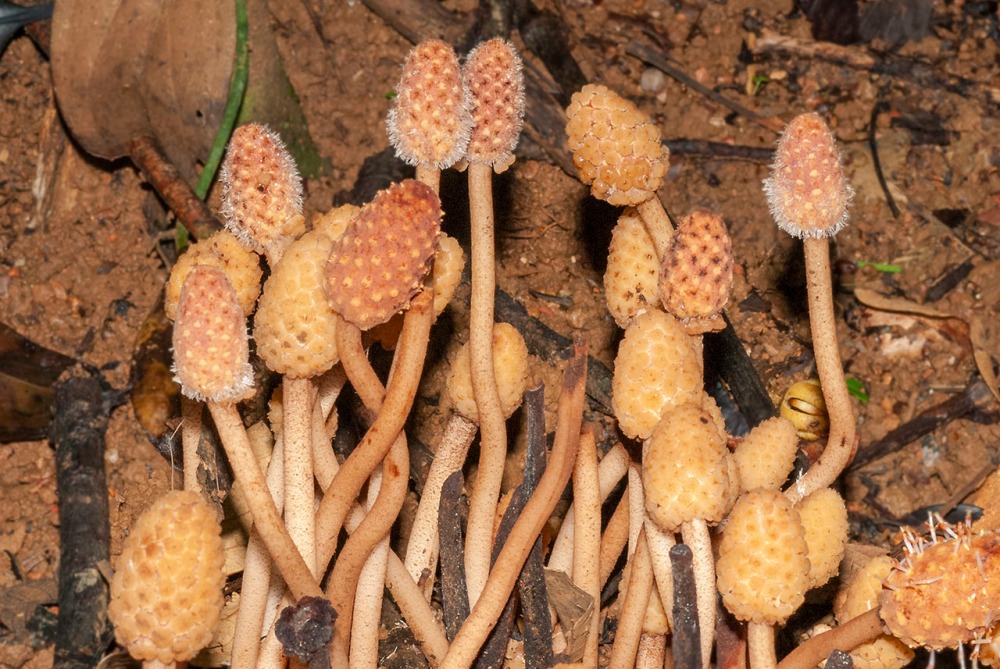
Helosis cayennensis
Now that is a typical flowering plant, but as with everything else, there are going to be some atypical forms. I will quite often have people come and ask me to identify some of the plants and animals they have been photographing during the course of the day. One puzzling sight is a weird little mushroom they may have found growing at the base of a tree. The plant in question is not a fungus, although it takes a lot of convincing of that fact before people will believe it, but rather a strange looking flowering plant, Helosis cayennensis, belonging to the family Balanophoraceae. Arising from subterranean tubers, Helosis cayennensis is a root parasite of other flowering plants. They lack chlorophyll and have a uniform tan color. It is not uncommon to see them but they only occur sporadically at the bases of trees.
Take a look at the photographs and try to decide if having seen this, you would have identified it as a flowering plant.
8.565093
-83.511169
It has been another grey, overcast and showery day today so the sightings were few and far between, more as a result of my not getting out rather than the wildlife staying away.
Apart from the obvious mammals, birds and butterflies, of which I maintain daily recorded observations, there are several other things that I take note of. I always pass by the pond two or three times a day to see what species of dragonfly may be hawking or breeding. At the moment there are three regular resident species, Micrathyria ocellata, Libellula herculea and Orthemis ferruginea. It is mostly the males that inhabit the area by the pond. Each individual is competing to set up the most advantageous perch to catch the sun, watch for prey and keep a look out for any female who may venture into the area. They are constantly busy; chasing away other males, hovering over the water before momentarily settling only to take off again and repeat the performance, those large eyes always in search of a meal.
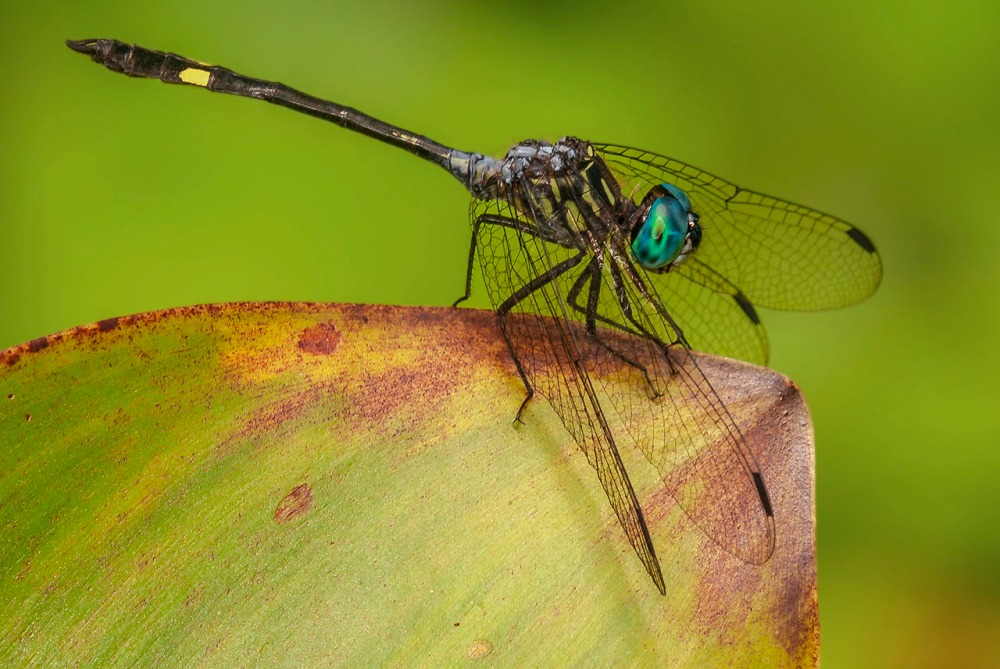
Rayadora, (Micrathryria ocellata)
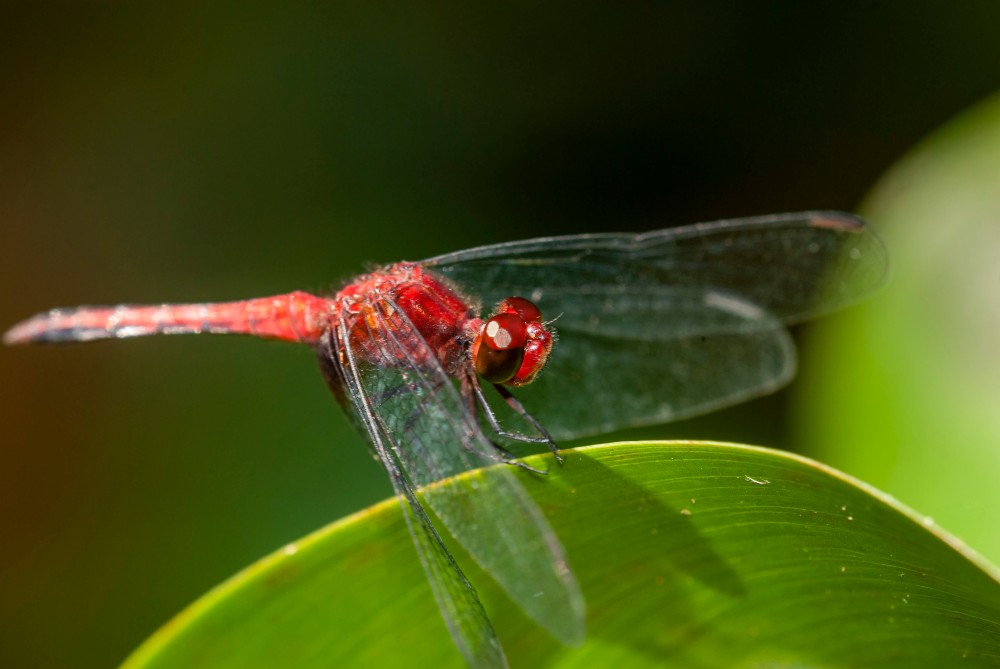
Roseate Skimmer, (Orthemis ferruginea)
I also like to keep a diary of the flowering and fruiting of the various plants. Some of them are very distinctive and pose no problems, others, despite having flowers or fruit that you would think unmistakable, don’t seem to appear in any of the guides to the flora of the area. Today I have been photographing two fruits that I found that need further investigation before I can name them. At the moment, we have the Hog Plums, (Spondias mombin), continuing to produce copious amounts of fruit as they have done for several months now. The Cannonball Tree, (Couroupita guianensis), is still flowering prolifically and has started to produce the distinctive “cannonball” fruits. Figs, well figs just don’t seem to stop fruiting. We also have a wonderful floral display being provided by the Golden Trumpet Vine, (Allamandra cathartica), with its vibrant yellow blossoms intertwined throughout the vegetation.
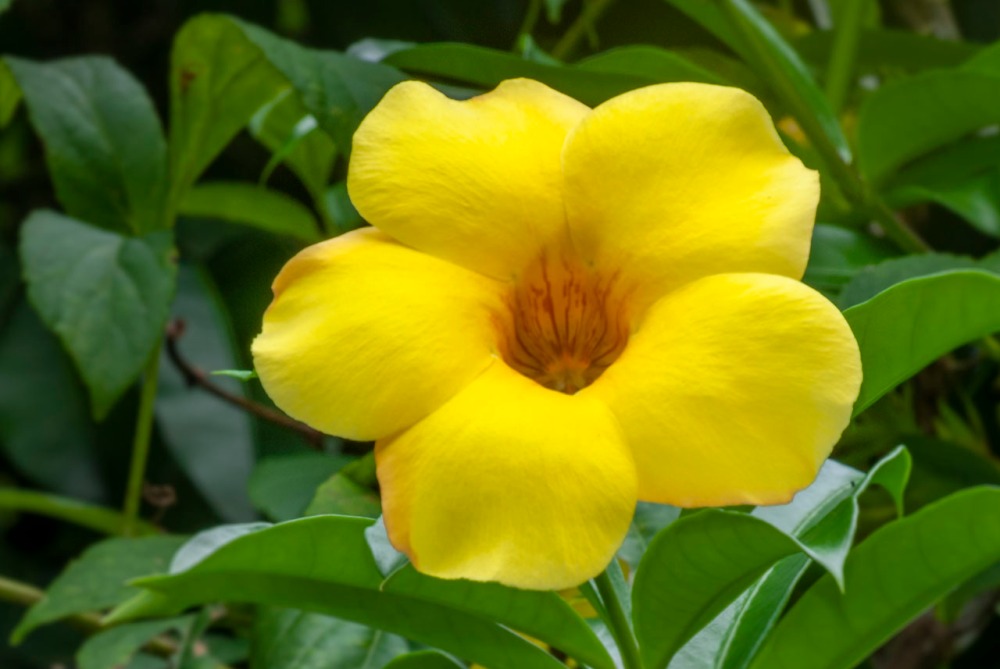
Golden Trumpet Vine, (Allamandra cathartica)
So, even though at first it might have seemed as if there was a little less variety than normal, once again, you just have to re-adjust your point of reference and you will see far more than you could wish for.
Grasshoppers: Jump To It
There are many other insects that I only ever see sporadically. This would include the praying mantises, walking sticks, grasshoppers and katydids. I do have a particular liking for these creatures, they all seem to have character, but unfortunately I don’t see them as often as I would like. But today I had several grasshoppers sitting perfectly placed at head height on some of the low shrubs and posing, (unintentionally), for photographs.
Grasshoppers and Katydids belong to the insect order Orthoptera which means straight wings. Grasshoppers can easily be distinguished from katydids by their short antennae whereas the latter have long filamentous whip-like antennae. Characteristic of both though are the huge rear legs which can propel them long distances when disturbed. Another feature of the Orthoptera is the ability of most males to “sing”. The sound is produced either by the rubbing together of the rear legs against the wings or the front and hind wings, a process which is known as stridulation. The sound can sometimes be melodic but other times can contribute to a constant hiss, an insect white noise, particularly in the evening. If they are producing sound then they should be able to hear. To this effect grasshoppers have hearing organs on the abdomen, katydids have hearing organs on the front legs. For the most part, orthopterans are herbivorous but there are some carnivorous katydids. They are a very mixed and diverse group of arthropods. If they stay around long enough without jumping or flying away, they are always worth a second look.
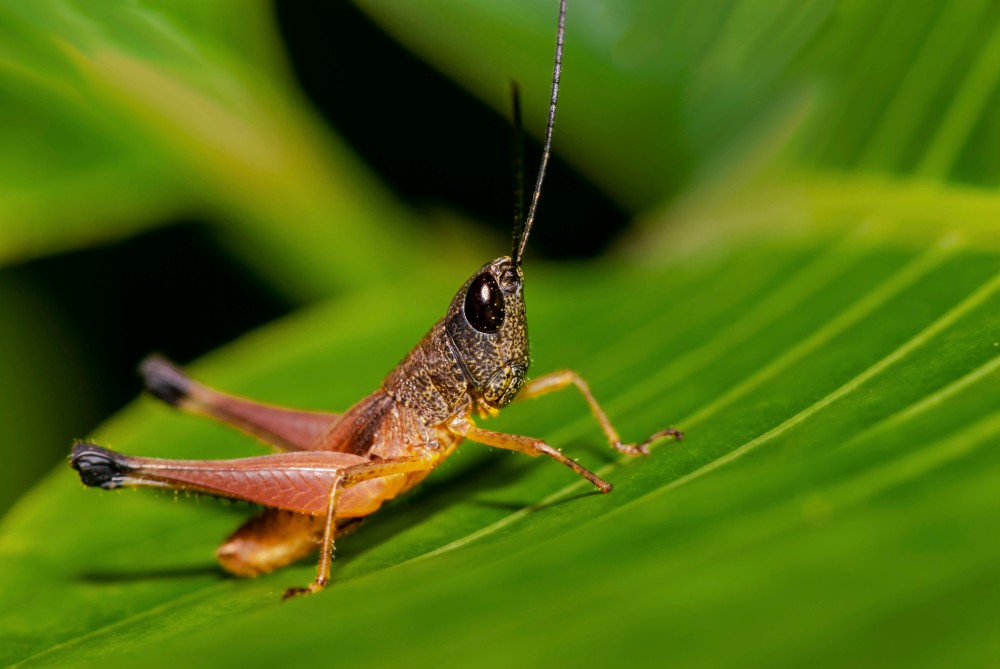
Grasshopper, (Acrididae sp)

Monkey Grasshopper, (Homeomastax dentata)
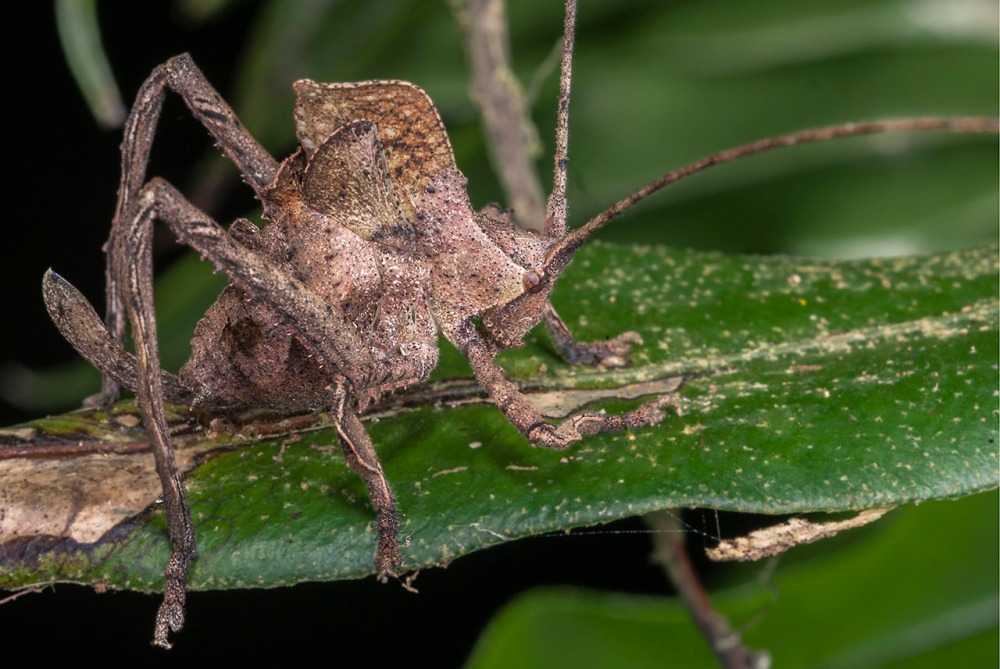
Leaf-mimicking Katydid, (Mimeta sp)
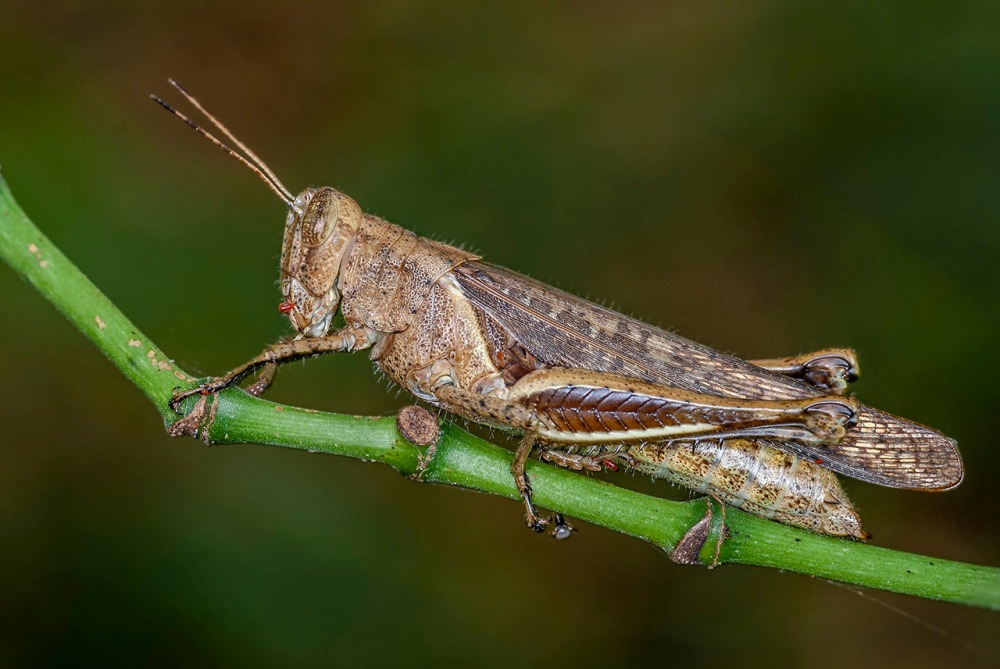
Grasshopper, (Acrididae sp)
8.565093
-83.511169
Today started as last night ended, not a cloud in the sky, and apart from a few scattered showers throughout the morning, that is how things stayed. This time of year we have the daily dawn chorus of Chestnut-backed Antbirds, Black-hooded Antshrikes, Bright-rumped Atillas and the raucous din of the Scarlett Macaws. All of this has, of course, been preceded by the early morning wakeup call provided by the Howler Monkeys. The ruckus is normally complemented and completed by the arrival of large numbers of Red-lored Amazons, whose higher pitched squawking simply adds to the cacophony.
Walking through a rainforest after a shower certainly gives the overall impression of dampness. It has been raining since April and so the creeks and rivulets in the forest have a constant supply of running water. The ground is both soft and sticky under foot. With the addition of a shower, the vegetation already dripping with moisture, now most certainly completes the visitors’ expectations of how a tropical rainforest should look.
Following lunch I went for a leisurely stroll around the grounds to see if any new birds and butterflies had turned up. One did, a butterfly I had not seen before, and guess what; once again I was not carrying my camera. Here in front of me on vegetation close to the ground was a very conspicuously patterned Metalmark. These are small and generally insignificant butterflies, but here was one with a dark background with a concentric series of white dashes and a bright red border to the hind wing, a White-stitched Metalmark, (Napaea eucharila). I ran over to my cabin to get the camera but when I returned, it was gone. So, I have found two new species in one week and no images to prove it. At least I have the images in my head and the records in my diary.
Costa Rican Frogs: The Largest and the Smallest
Here we are looking at two extremes; one of the largest and one of the smallest frogs in the forests of the Osa Peninsula.
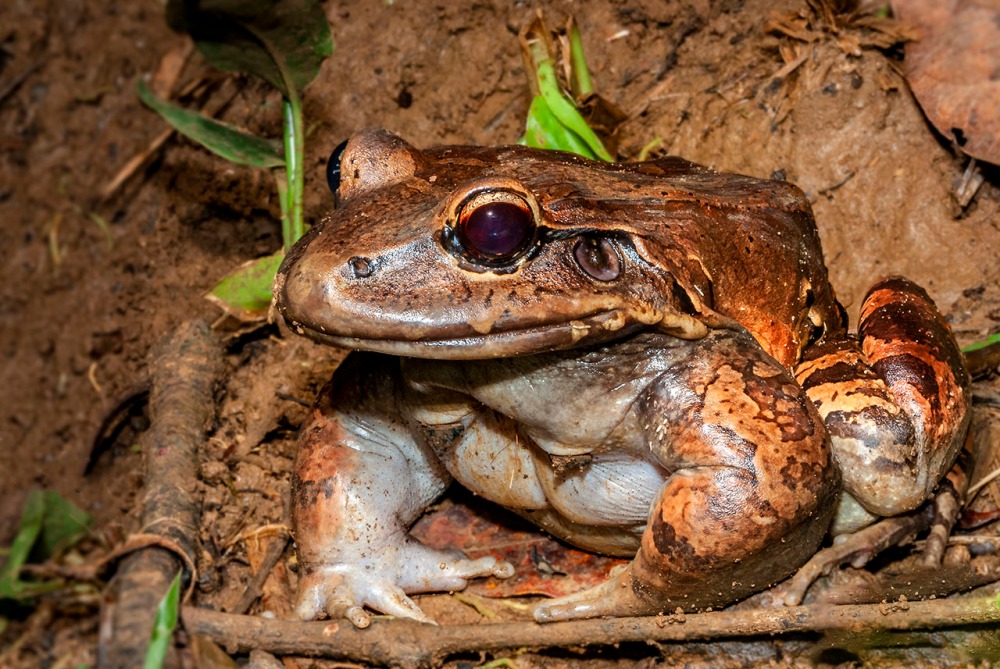
Savage’s Thin-fingered Frog, (Leptodactylus savagei)
Savage’s Thin-fingered Frog, (Leptodactylus savagei), is a veritable behemoth of a frog, second only in size to the female Marine Toad. It is the only amphibian we know of that eats scorpions, but they are opportunistic feeders and will eat smaller frogs, snakes, really anything smaller than themselves. Like the Marine Toad, it is very poisonous, having a skin secretion called Leptodactylin. If you handle the frog it is very uncomfortable, but if you then rub your eyes, nose or mouth, in fact any mucus membrane it can be become a very distressing situation. They do have predators though, more or less the same predators as Marine Toads, i.e. Opossums and snakes. To that effect they have a secondary defense. When you catch one it will scream like a baby. The screaming may shock the predator into letting it go or the commotion could attract the attention of any other predator in the area which subsequently may attack whatever is trying to eat the frog, but most importantly, the screams very closely resemble the alarm calls of young caiman. If there any adult caiman in the area, they will charge in and attack the creature predating upon which will hopefully, as far as the frog is concerned, allow it to make its escape.
Savage’s Thin-fingered Frog is a foam-nester. The male comes to the water first. He has massive front legs and gives emits a “Whoop, whoop” call. The female joins him later, he grabs on to her with his massive front legs, he has two sharp spines on his chest which also help secure her until she is ready to lay eggs. Once the female has spawned, the male fertilizes the egg mass and then using his hind legs he whips the eggs up with water from the pond and mucus from his body to produce froth. The eggs develop in the froth until about 8 days at which point the froth dissipates and the tadpoles as they now are have to complete the normal tadpole stage in the water.
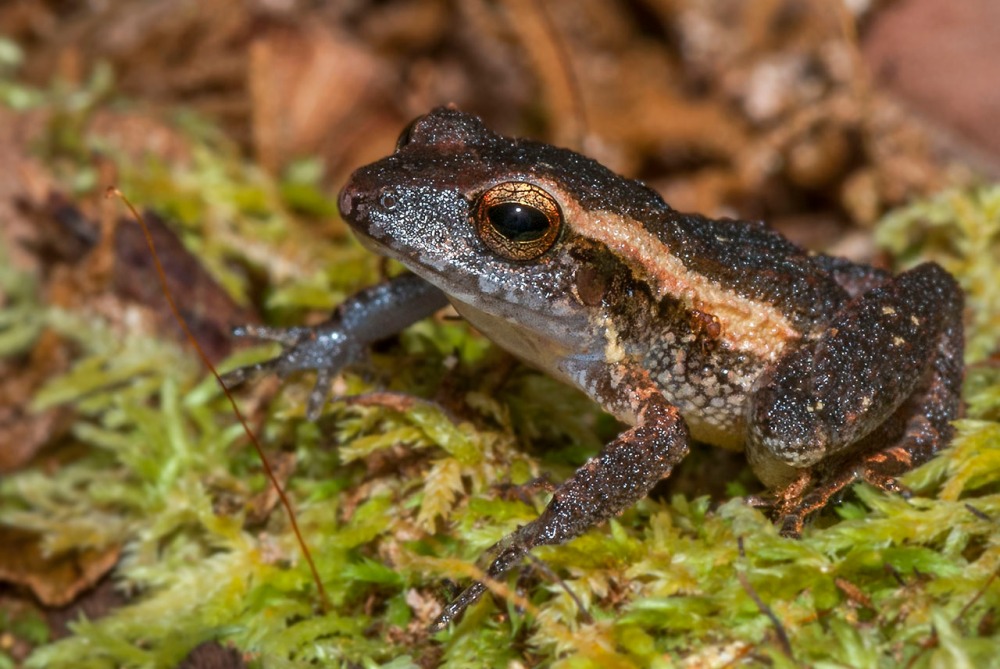
Stejneger’s Rain Frog, (Craugastor stejnegerianus)
Closely related to the huge Savage’s Thin-fingered Frog is probably one of the smallest frogs in Costa Rica, the tiny Stejneger’s Dirt Frog, (Craugastor stejnegerianus). These are tiny frogs that live terrestrially on the forest floor. If you ever spot a slight movement down by your feet as you on the forest trails, close examination will quite often reveal a frog no bigger than your fingernail.
Stejneger’s Dirt Frog is one of the rainfrogs. They do not need to come back to the water to breed. They pair up and lay only 10 – 30 yolk filled eggs, fairly large in comparison to the frog, in the leaf litter on the forest floor. The whole process of development takes place within the egg so there is no free swimming tadpole stage. After about 8 weeks, you will find emerging from the egg a tiny copy of the adult.
So there you have it, the little and large of the amphibian world.
8.565093
-83.511169
Skippers: Best Seen In Close Up
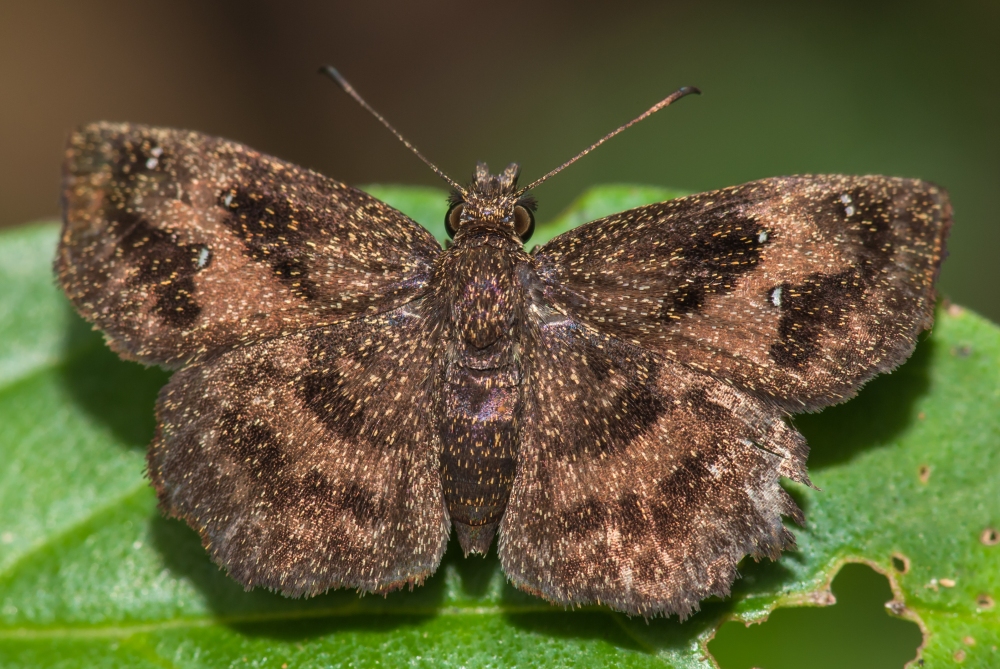
Mazans Scallopwing, (Staphylus mazans)

Tropical Checkered Skipper, (Pyrgus oileus).
Skippers, you probably wouldn’t even notice them. Many of the skippers are small, less than the size of your little fingernail, chocolate brown in color and fly close to the ground. Even when you do capture one on camera, the diagnostic features required to identify it may not be obvious. Quite often the female has different coloration and markings to the males. Literature pertaining to skippers, guides and keys; they are all sadly lacking. Skipper identification is therefore left to the experts and even then that may take some time. I too, initially paid small attention to them, at least until I started to photograph them. For whatever reason they seem to be sensitive to sound, light or the slightest movement, so when it comes to capturing the image you have spent so long composing, as the lens focuses, off they go. If using flash, you also need to be using a high shutter speed because if you are using anything below 1/250 sec all you will have taken is a photograph of is the leaf where the skipper had been perched.
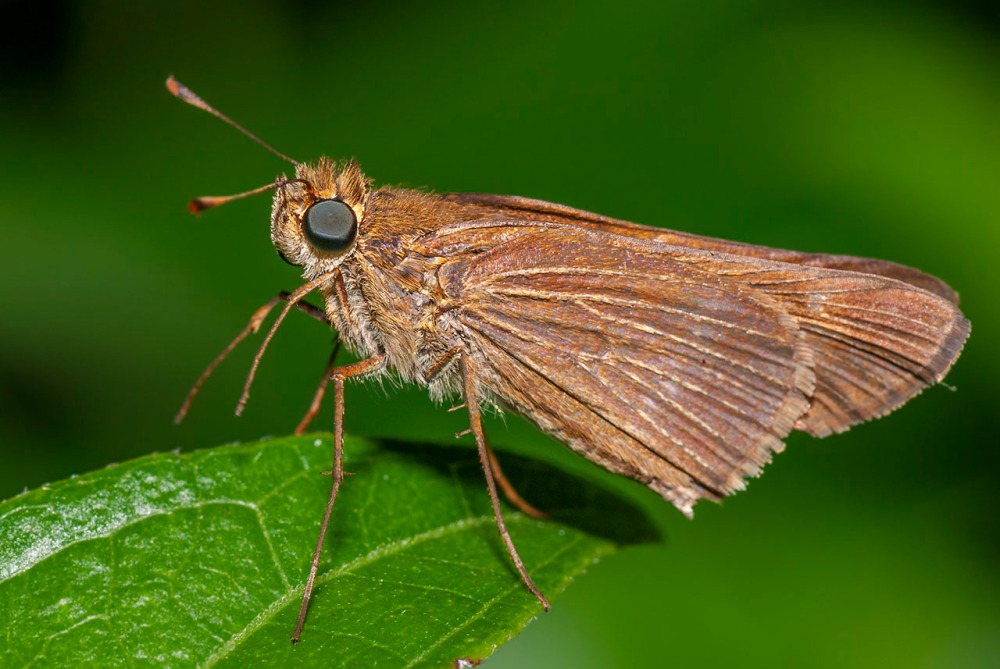
Purple-washed Skipper, (Panoquina lucas)

Trailside Skipper, (Anthoptus epictetus). Flash Jump.
8.565093
-83.511169














































